North America is home to a wide range of yellow moths. Most moths of yellow color are present in the Eastern parts of the US.
Southern states are also home to a large number of moths, many of which are yellow.
Most yellow moths in the US have a wingspan between 10 and 60mm. They have a long lifespan in the South.
Some of the longest-living yellow moths are found in Southern states where they are known for having up to 3 broods per year.
Yellow moths in Northern states can be as damaging as those in the South. They can feed on various crops but most damages are inflicted on trees such as birch, pine, and oak.
The damages caused by yellow moths aren’t immediately visible on hardwood trees. However, their damage can become visible within a few years after a tree has been invaded by these moths or their caterpillars.
Not all yellow moths in North America are pests. Most moths can migrate from their typical host to other plants and trees on the other hand.
Here are the most common yellow moths found in North America.
Table of Contents
1. Isabella Tiger Moth
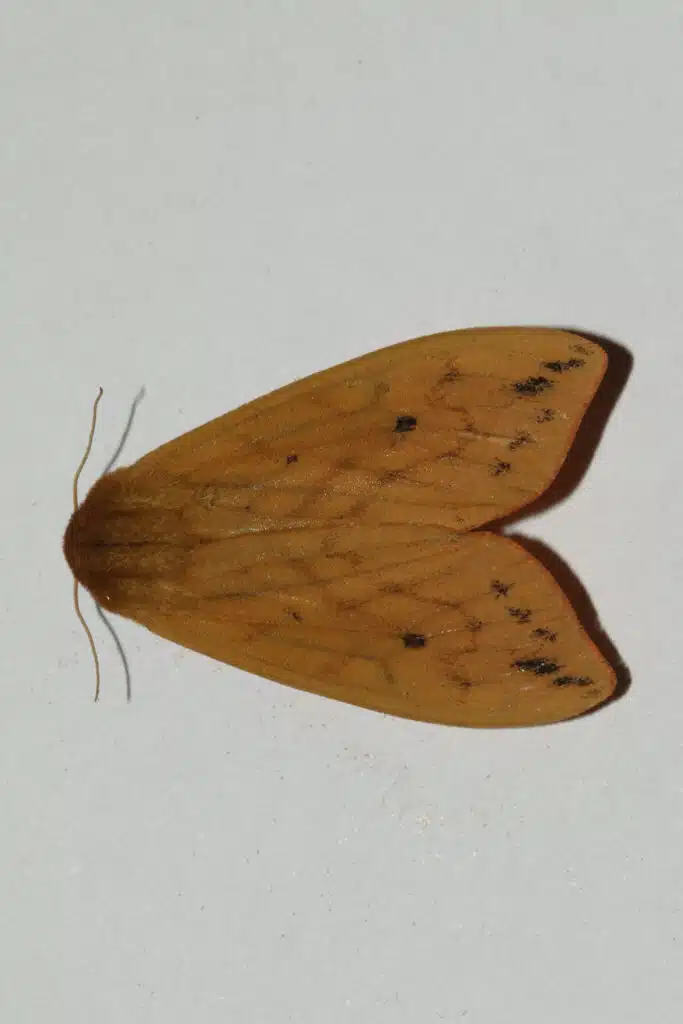
Isabela Tiger Moths (Pyrrharctia isabella) are also known as Wooly Bears, a species popular in North American culture.
This moth species are adapted to living in temperate and even cold climates.
It has a yellow color with orange sections and a dark orange to red upper body and head.
Tiny black spots decorate its wings and its body.
Isabela Tiger Moths feed on a wide range of plants as adults and even on tree leaves as caterpillars.
Touching the caterpillars of the species isn’t recommended as the sharp hairs covering the larvae can cause skin inflammation that lasts hours.
2. Imperial Moth
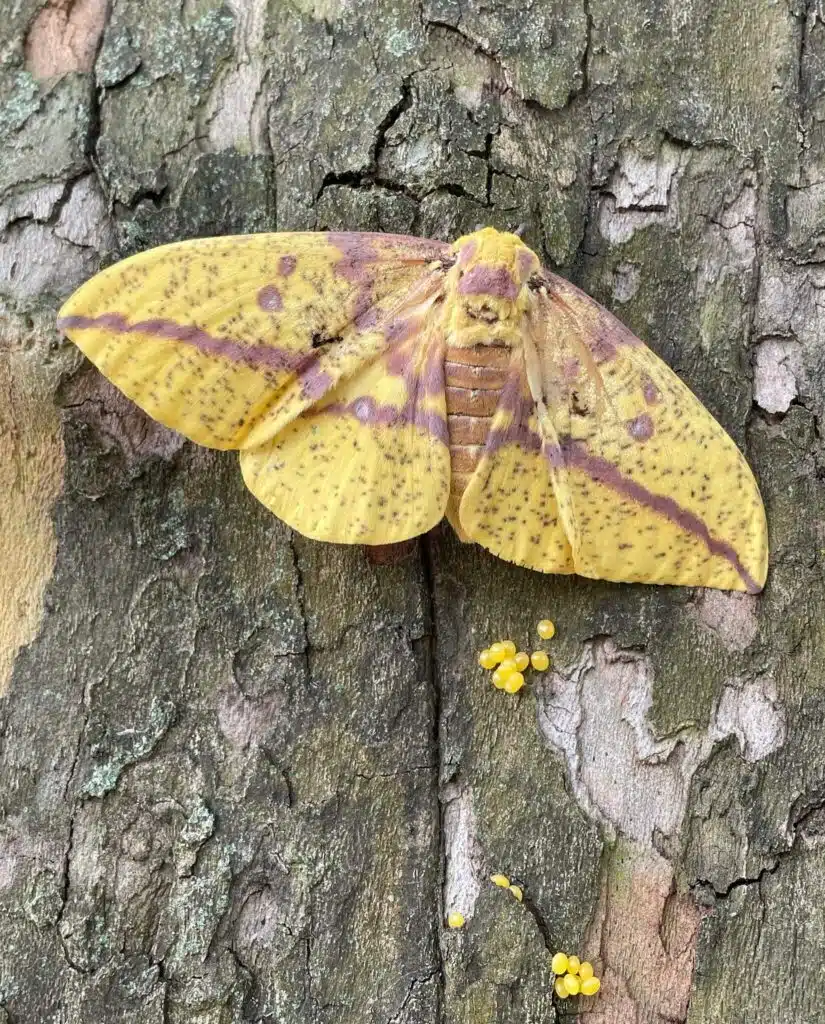
Imperial Moths (Eacles imperialis) are a common species across North America. This moth is mostly yellow.
It has red or brown blotches as well as brown eyespots. These darker blotches are specific to Imperial Moths across the country but they tend to be darker with the moths in the Northern territories.
Large size is also specific to these moths. They can grow to a varying wingspan but adult Imperial Moths never have a wingspan under 3 inches.
The wingspan can also grow to 6 inches.
Imperial Moths are some of the most common species across The Atlantic Coast of the US and Canada. They have a widespread distribution outside North America.
Imperial Moths also live in South America.
3. Rosy Maple Moth
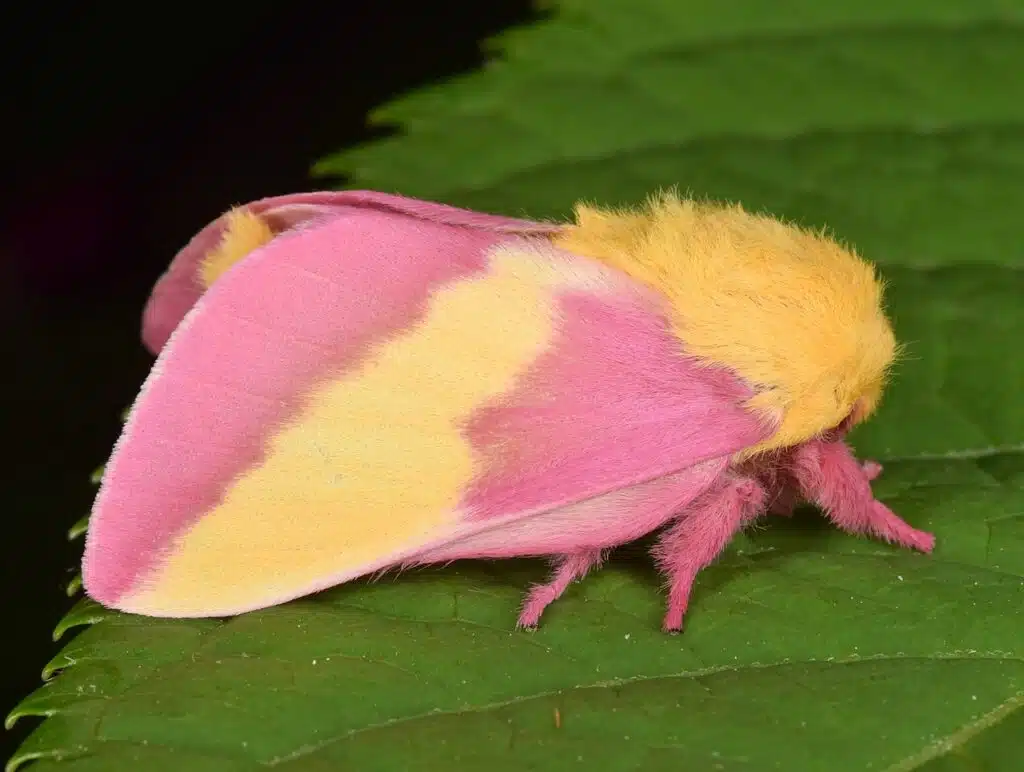
Rosy Maple Moths (Dryocampa rubicunda) are native to the US. This species can have different coloring depending on its region but it’s generally yellow and pink.
Both yellow and pink sections across its wings are considerable with some morphs being dominated by one of these colors. A rare morph of the Rosy Maple Moth is white.
This species of moths gets its name from the maple trees it lives on. Red maples and sugar maples are some of the most common the Rosy Maple Moth is seen, especially its caterpillars.
The easiest time to see a Rosy Maple Moth is in its caterpillar stage. Caterpillars of this genus live in groups up until their last instar before moving on their own as adults.
4. Io Moth
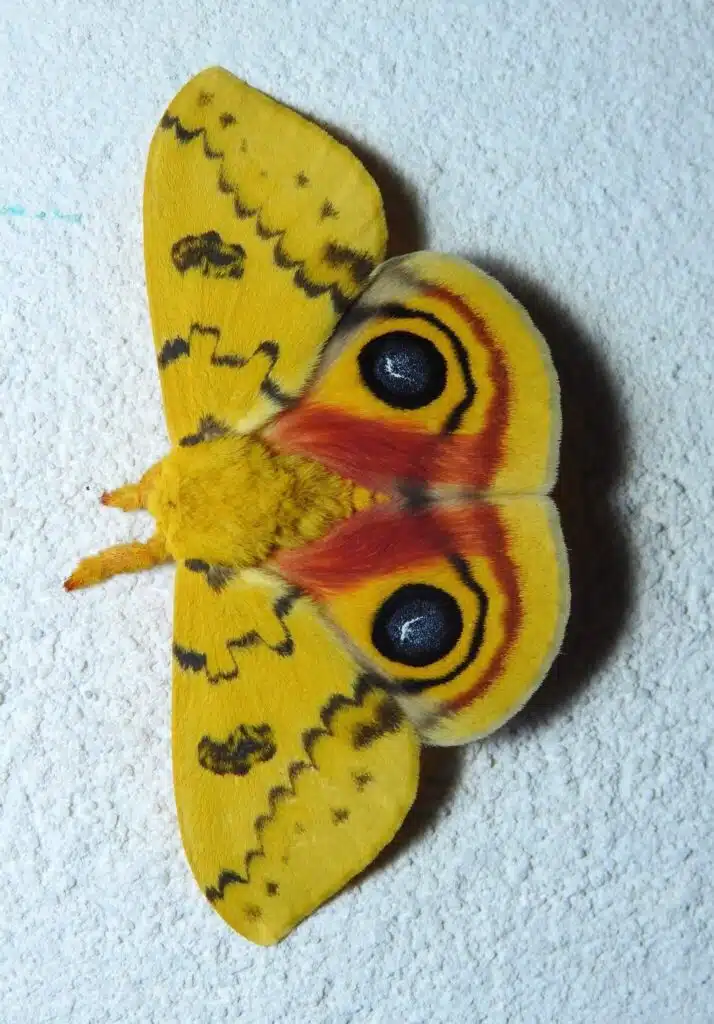
Also known as The Corn Emperor Moth, Io Moths (Automeris io) live in an extensive habitat in the Eastern parts of the US.
Moths of this family are known for their colorful wings which are mostly yellow. Io Moths have yellow forewings and yellow hindwings.
Large eyespots are also seen on the wings to keep predators away.
You can find this species across multiple territories, mainly in woodlands.
Hardwood trees tend to be the most common host of the species with fruit-bearing trees also known to be a good host.
Most Io Moths prefer maples, alders, birches, or boxelders. In the absence of these host trees, Io Moths can also move on towards pear, cherries, and currants.
Willows can also host Io Moths to a lesser extent.
5. Chickweed Geometer Moth
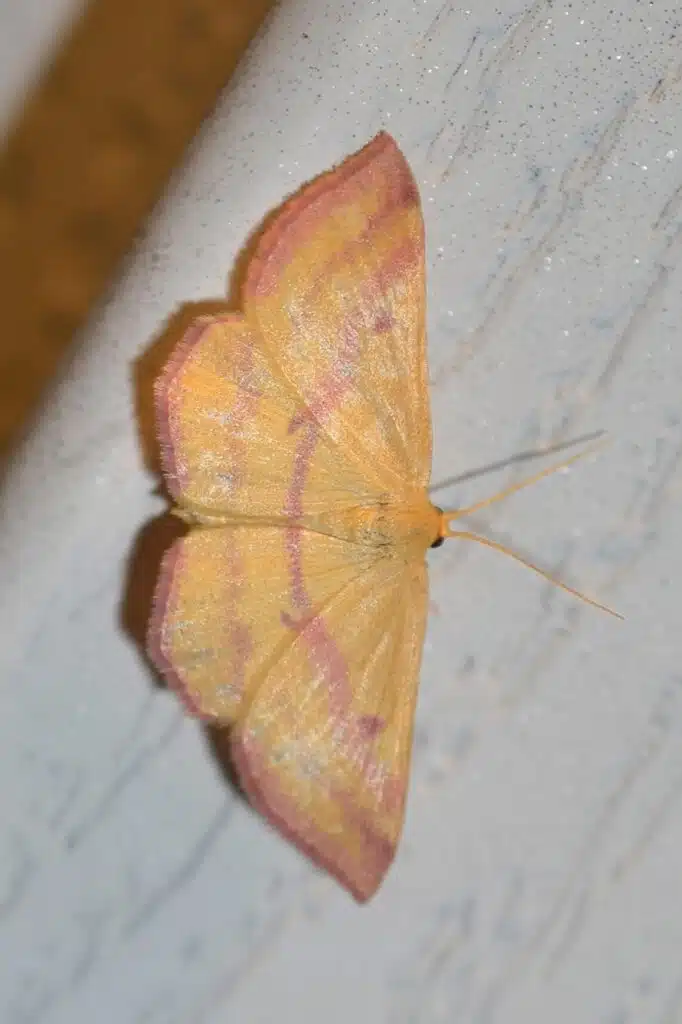
Chickweed Geometer Moths (Haematopis grataria) are a species of yellow and pink moths. Yellow is the dominant color of the species.
Its forewings and hindwings are yellow. 2 pink lines are visible across its wings.
Pink is also seen on the wing margins.
2 pink dots similar to eyespots are further visible on its upper wings.
As the name of the species implies, this moth commonly feeds on short flowers such as chickweed.
6. Horned Spanworm Moth
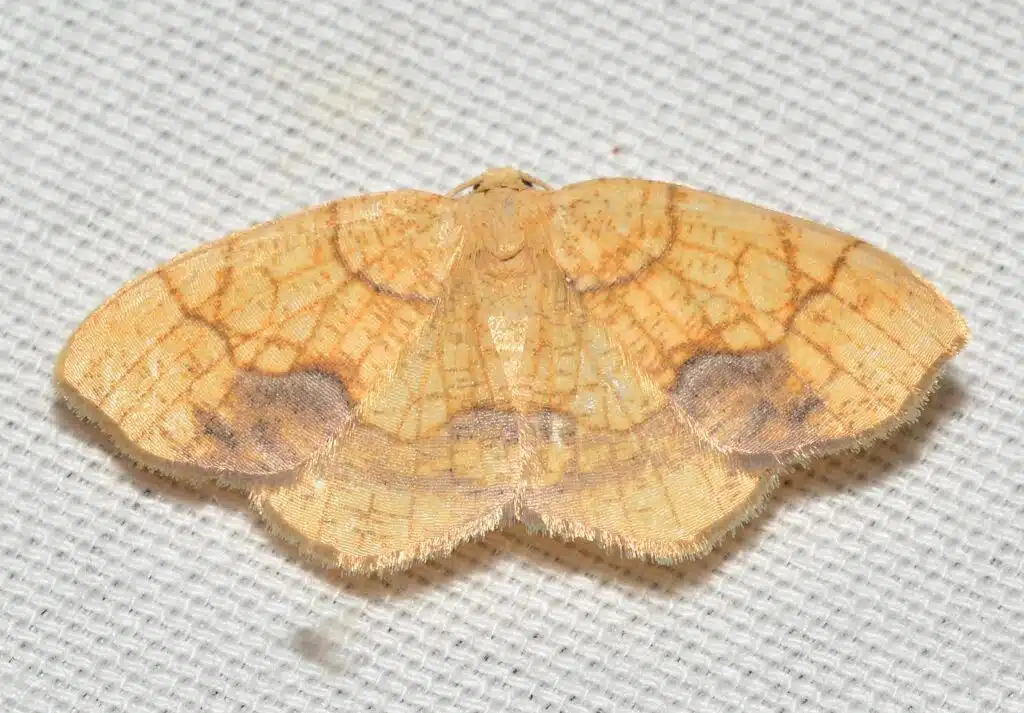
Horned Spanworm Moths (Nematocampa resistaria) are a native North American species that uses wood and tree-mimicking colors.
Its wings are mostly yellow with brown veins and brown lower hindwings which makes the species resemble tree trunks or tree bark.
Even the larvae of the species resemble twigs or roots so that it escapes predation.
This species is further known for having a rather short wingspan which is never longer than 25mm.
Horned Spanworm Moths feed on multiple species of pine trees and are only found at high elevations where they can find species such as hemlock.
7. Carrot Seed Moth
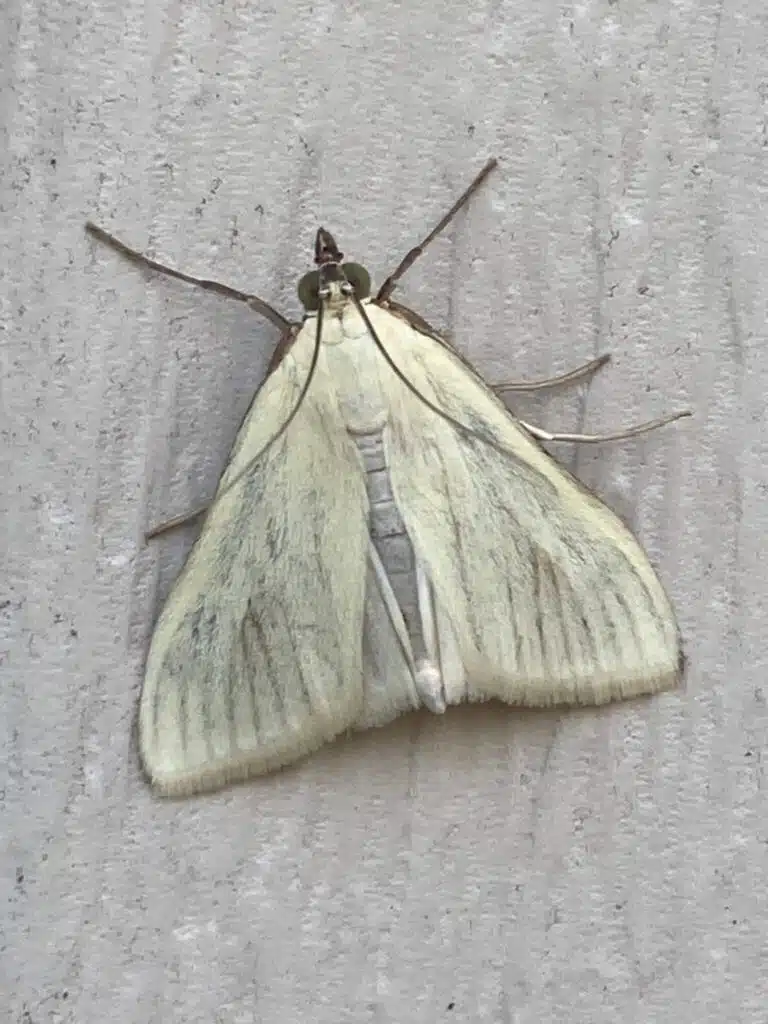
Carrot Seed Moths (Sitochroa palealis) aren’t carrot pests as they only feed on the nectar of wild carrot flowers.
These types of moths have a pale yellow color. This color is almost uniform across the wings. Gray veins decorate the pale yellow wings of the Carrot Seed Moth.
Some of these contrasting specifics of the species are also seen on its caterpillar which has pale yellow and black contrasting coloring.
You can often see the colorful caterpillar of the species on wild carrots which they also use for food, as adults.
This species is seen flying during the summer months. With sufficient food, it reaches a wingspan of up to 34mm.
8. Deep Yellow Euchlaena Moth
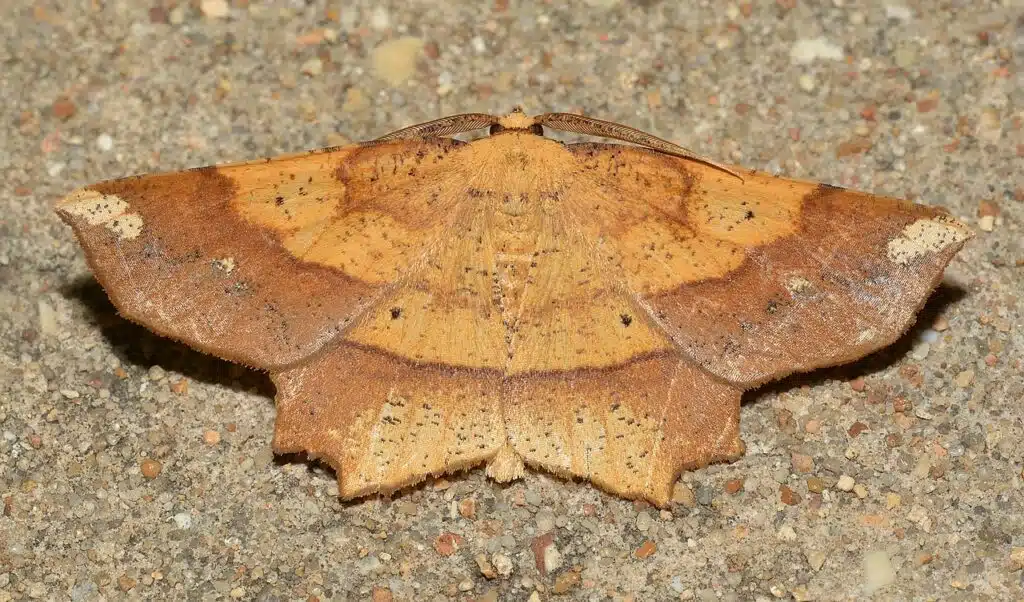
A common sight in woodlands across Northeastern parts of the US, the Deep Yellow Euchlena Moth (Euchlaena amoenaria) is a rare species of mimicking moths.
These moths only live in woodlands and their habitat impacts their color.
Dark yellow is the main color of the moths with brown being a secondary color. When it rests, this moth appears similar to a dry leaf.
Only found on trees with falling leaves, this moth grows to a maximum wingspan of 50mm.
Its wingspan makes it one of the larger types of yellow moths that live in woodlands.
You can find a similarly-colored caterpillar of the species on various types of trees. The caterpillar feeds on tree leaves.
9. Reticulated Fruitworm Moth
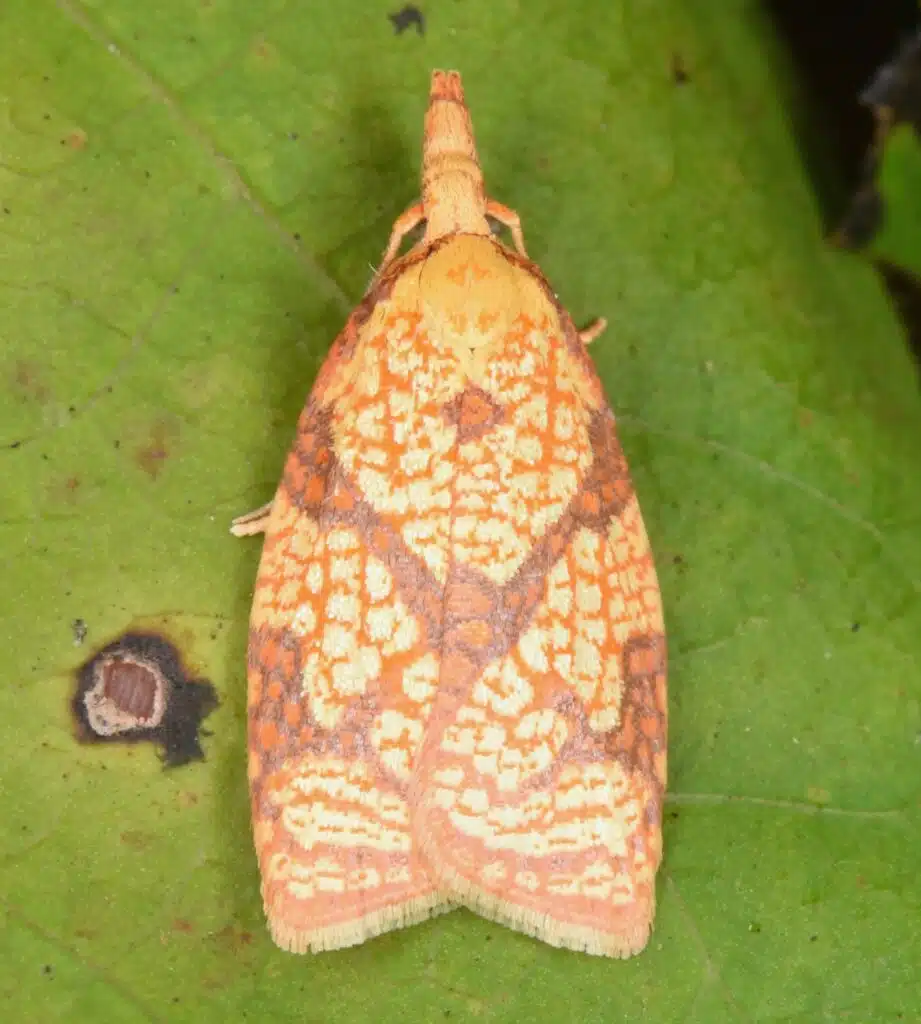
Reticulated Fruitworm Moths (Cenopis reticulatana) are found in Eastern US states. Habitats next to the Atlantic Coast are the areas where the species is found in its highest numbers.
This type of moth has an orange and a yellow color depending on its gender. Males have an orange-brown color with yellow spots and dark brown bands.
Females of the species have mostly yellow forewings with orange and black patterns. Their hindwings are completely white.
The body of the female Reticulated Fruitworm Moth is also yellow.
Often seen on fruit-bearing trees, the larvae of the species bears no resemblance in coloring. The larvae have a transparent white color with blue nuances.
10. Packard’s Wave
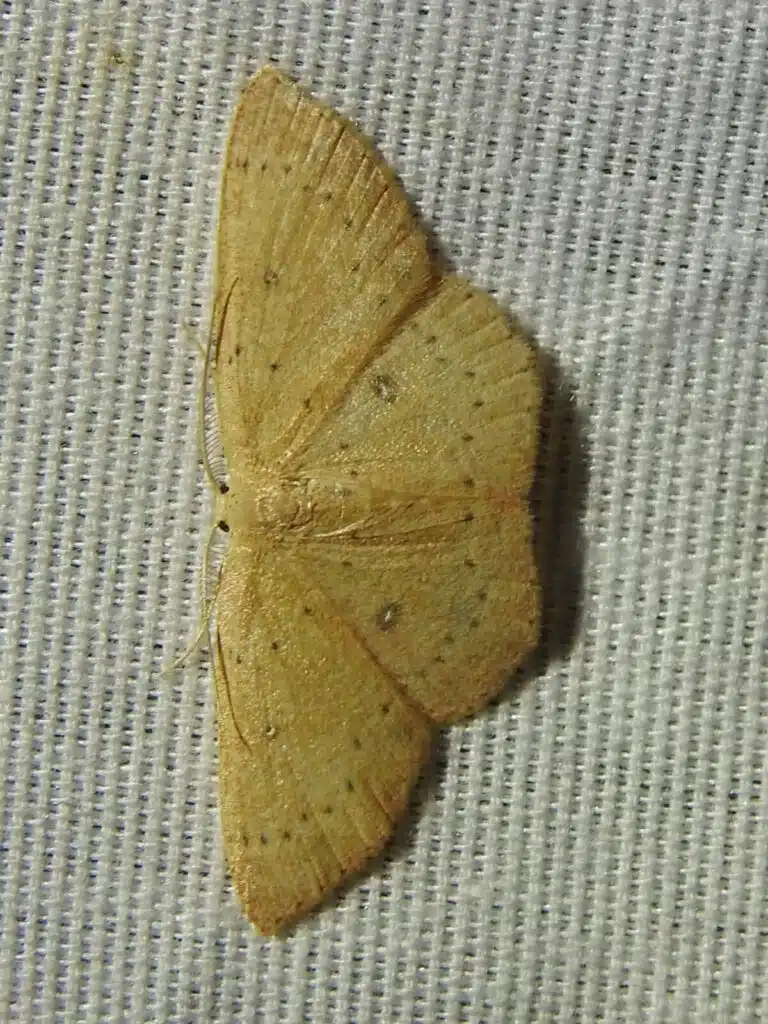
Common in states such as Florida and Texas, Packard’s Wave (Cyclophora packardi) is a species dominated by yellow and brown colors.
Yellow is the undertone color of its wings with brown overlays covering it up almost completely.
The upper forewings represent the main area where yellow coloring is visible the most.
This species is small compared to other types of yellow moths. It has a wingspan that ranges between 17 and 23mm.
Moths of the Packard’s Wave genus have a long flight season as they mostly live in the South. They are active from April to September.
11. Basswood Leafroller Moth
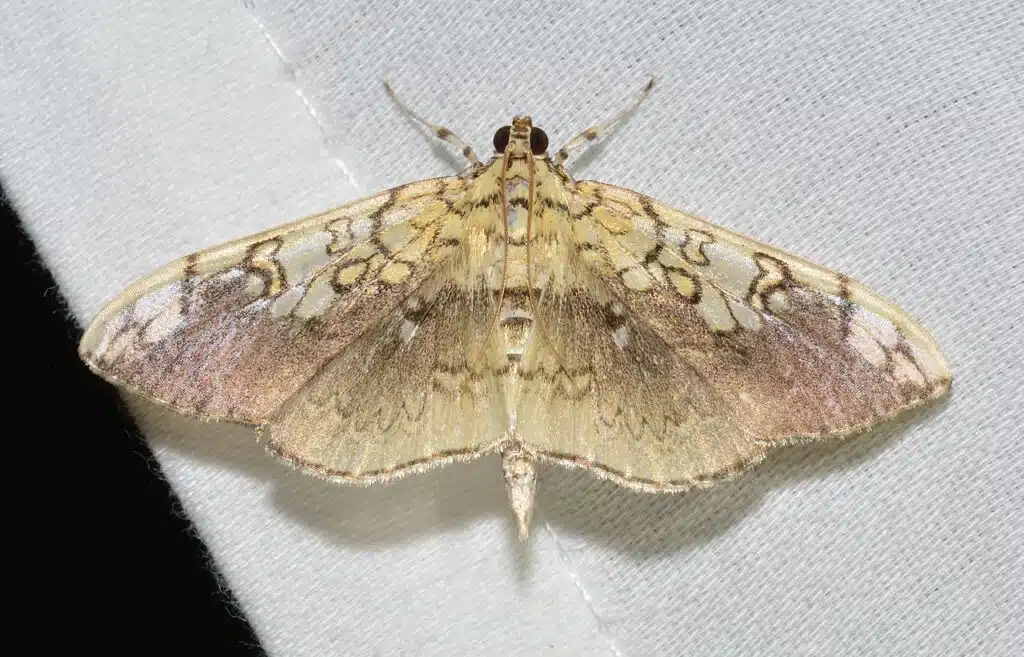
Native to the US, Basswood Leafroller Moths (Pantographa limata) get their names from the basswood tree adult moths consume.
Oak is another common tree the species is seen on.
Most Basswood Leafroller Moth caterpillars are seen on linden. Eggs are rolled in the leaves of linden for protection.
This species has a yellow and brown color. Its upper wings are dominated by yellow coloring whiles its hindwings show both brown and yellow colors.
These moths have yellow bodies with white bands.
You can find the moth in the US and Canada. Basswood Leafroller Moths are a common sight in New York.
12. Black-waved Flannel Moth
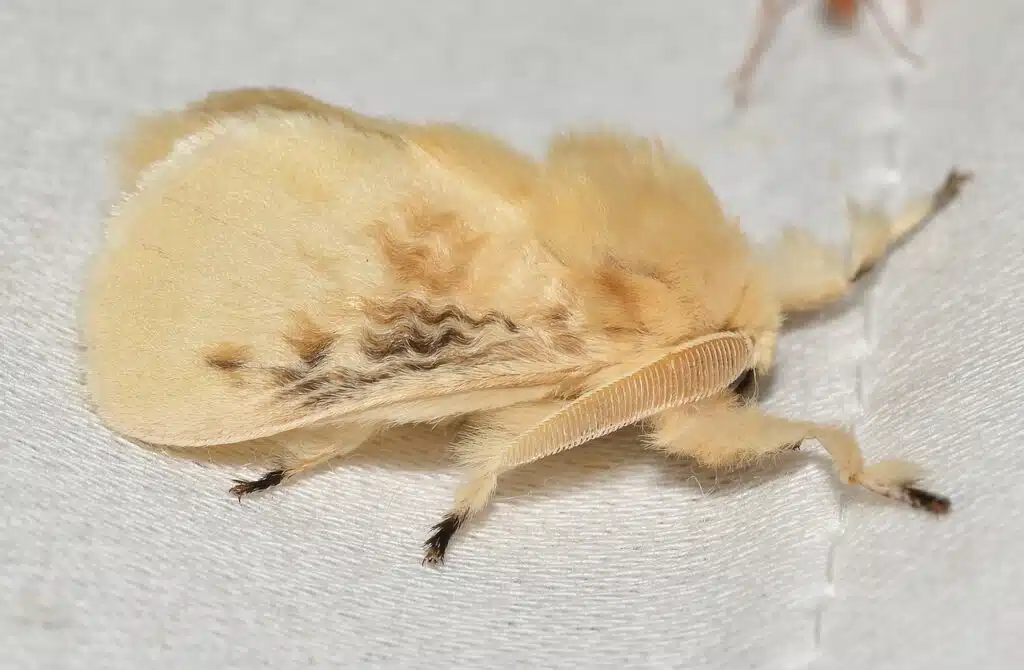
This hairy moth species (Megalopyge crispata) is known for having a pale yellow color on its outer wings and darker yellow colors around the body.
Light brown and black patterns are further distinguishable on its wings.
Its legs have a pale yellow to white color with long hairs as those on the body.
Only native to the Eastern US states, Black-waved Flannel Moths are seen on trees as adults and as caterpillars.
The caterpillar of the species should be avoided as it can sting and cause skin irritation.
This species is active from spring to fall until late October.
13. Ornate Tiger Moth
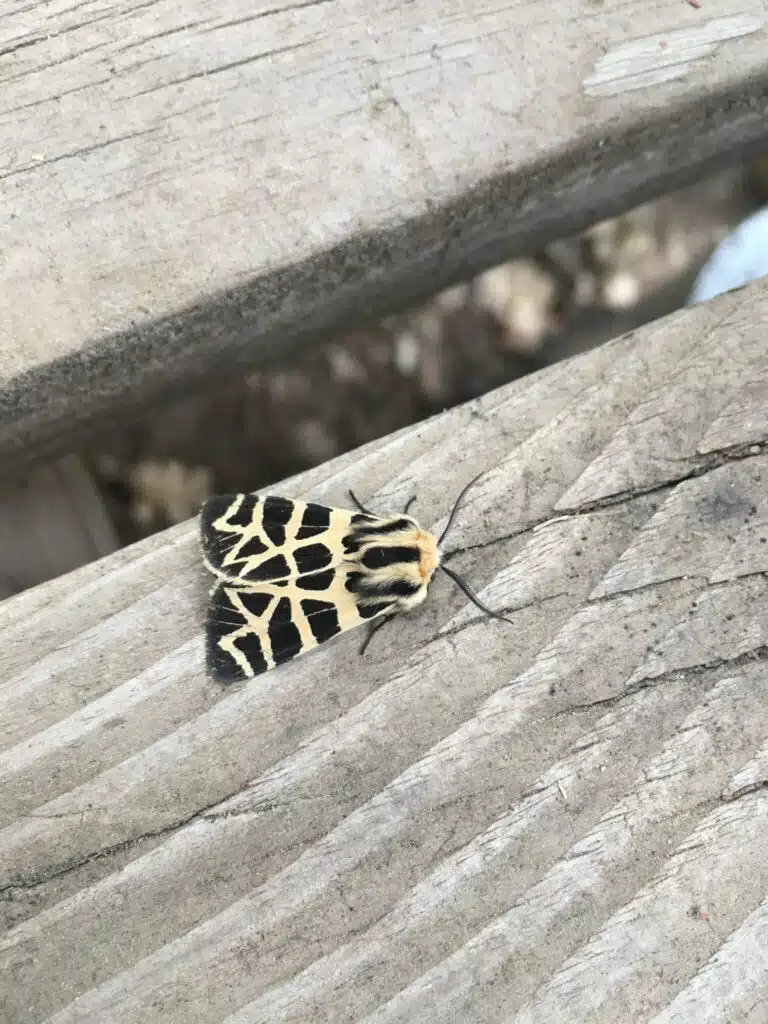
Ornate Tiger Moths (Apantesis ornata) get their names from their rich patterns on the wings which have black and yellow coloring specific to tigers.
The wings of the species are mostly black. Yellow lines that form different patterns are further visible on the wings of the species.
Orange and black coloring is specific to the hindwings of the species.
While not as large as other moths (Orange Tiger Moths only grow to 20mm), these moths stand out due to the contrasting black and yellow patterns and wide orange bands on the hindwings
These moths have a black body that shows yellow and black hairs around the head.
14. Maple Spanworm Moth
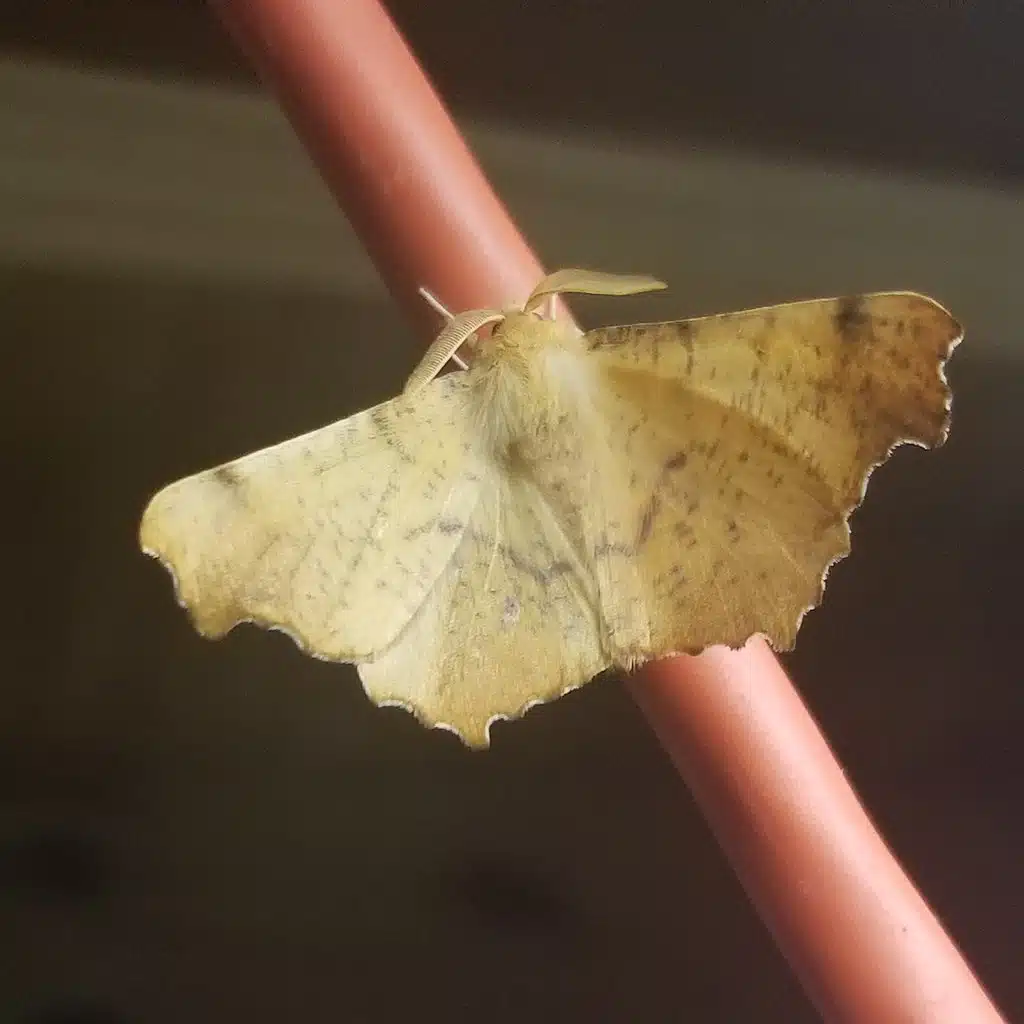
Maple Spanworm Moths (Ennomos magnaria) have a dark yellow to brown color which mimics falling fall leaves.
These moths are always seen around tall trees which explains why they take the look at falling leaves in front of potential predators.
Apart from a yellow to brown color, this species also shows tiny black dots across the wings.
You can find both caterpillars and adults of the species on the same hardwood trees such as maple and alder.
The Maple Spanworm Moth first emerged in May with adults remaining active until August-September.
15. Yellow-spotted Renia Moth
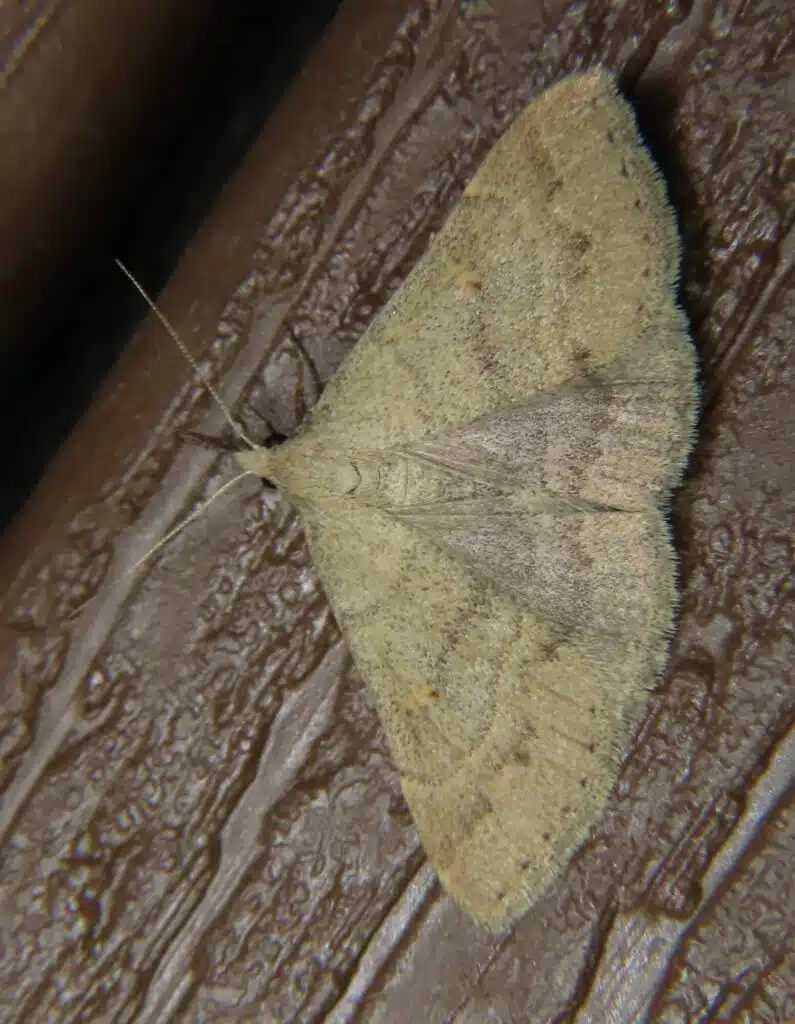
The Yellow-spotted Renia Moth (Renia flavipunctalis) is native to Eastern North America.
A base yellow color with gray to brown overlays is specific to the species. These moths are further known for having small yellow dots across the wings.
You can find these moths in woodlands, gardens, parks, or on trees in open areas. An active season
from June to August is specific to this species.
Yellow-spotted Renia Moths are known to have a different diet compared to other yellow moths in the East.
This species often feeds on dead and even decaying leaves. The moths also feed on fresh leaves right from trees.
16. Pale-winged Crocidophora Moth
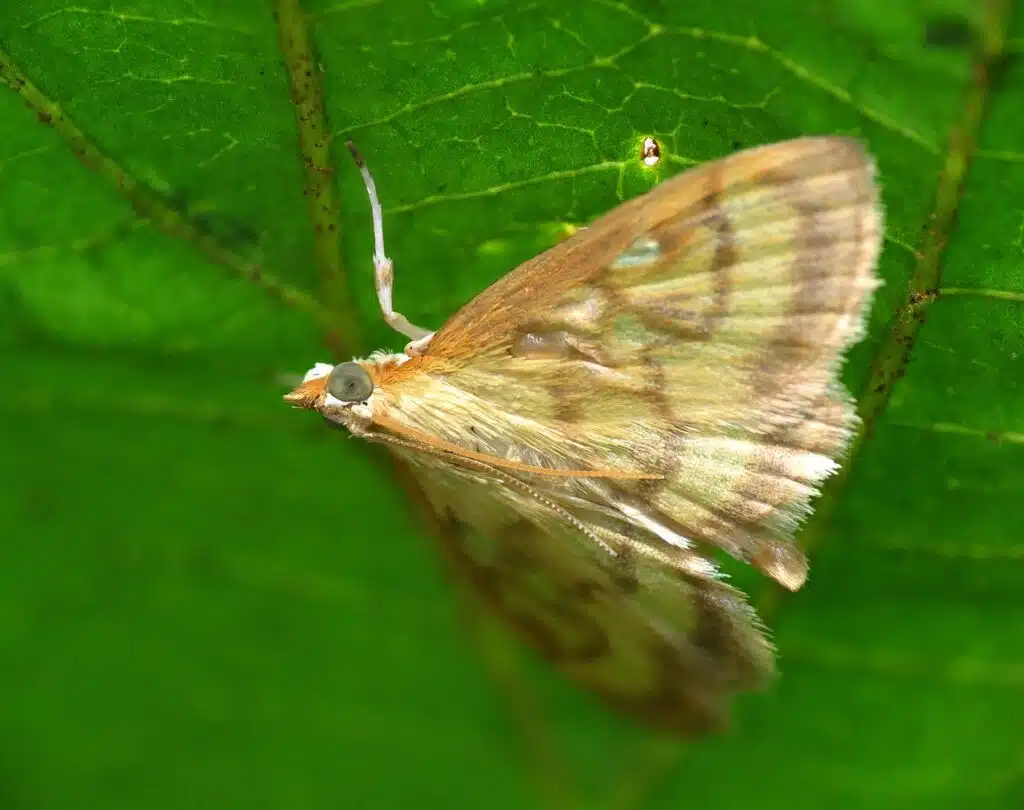
Also native to states on the Atlantic Coast, the Pale-winged Crocidophora Moth (Crocidophora tuberculalis) is among the species with mostly yellow wings.
A pale yellow color is specific to this species.
Barely-visible brown lines decorate its wings and the margins of the wings.
Pale yellow is also the dominant color of the body for the species.
These pale yellow moths are some of the smallest in North America. They grow to a wingspan of up to 15mm.
Pale-winged Crocidophora Moths are active from the early season since they begin flying in March. They only remain active until August, like most small moths of this genus.
17. Pondside Crambid Moth
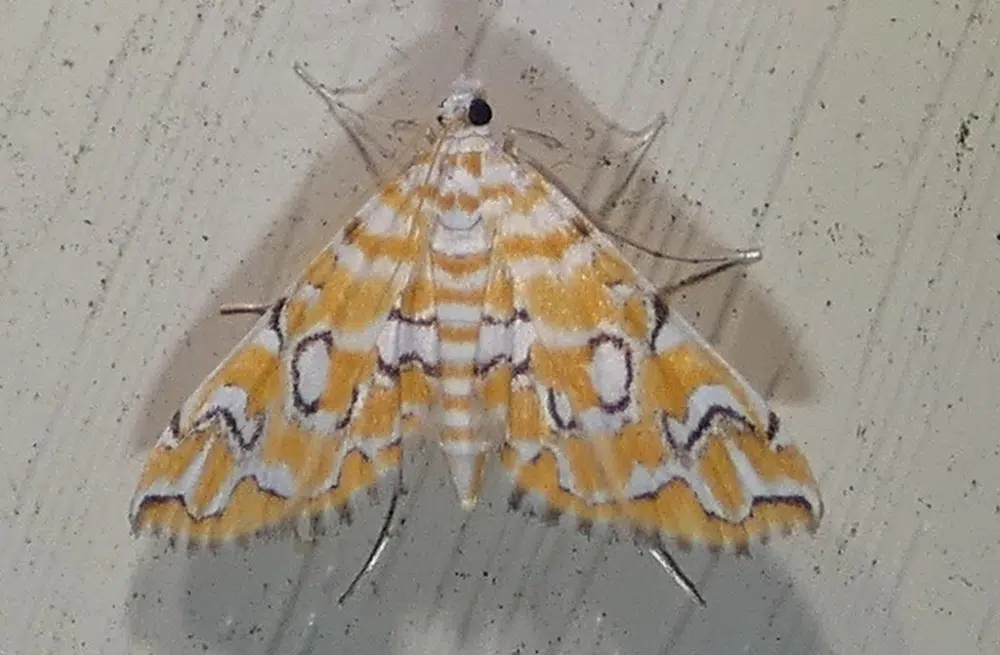
Also native to the Northeast, the Pondside Crmabid Moth (Elophila icciusalis) gets its name from its semi-aquatic nature.
Its caterpillars are all found next to water sources such as lakes, ponds, and rivers. New York is one of the urban areas the species is common in.
The coloring of these moths is complex but dominated by yellow nuances.
Alternating black and yellow bands are seen across its wings.
These bands are further decorated with black lines and patterns as well as with brown and light brown margins.
Pondside Crambid Moths have a similar size to other yellow moths on the East Coast. A maximum wingspan of 21mm is specific to the species.
18. Rose Hooktip
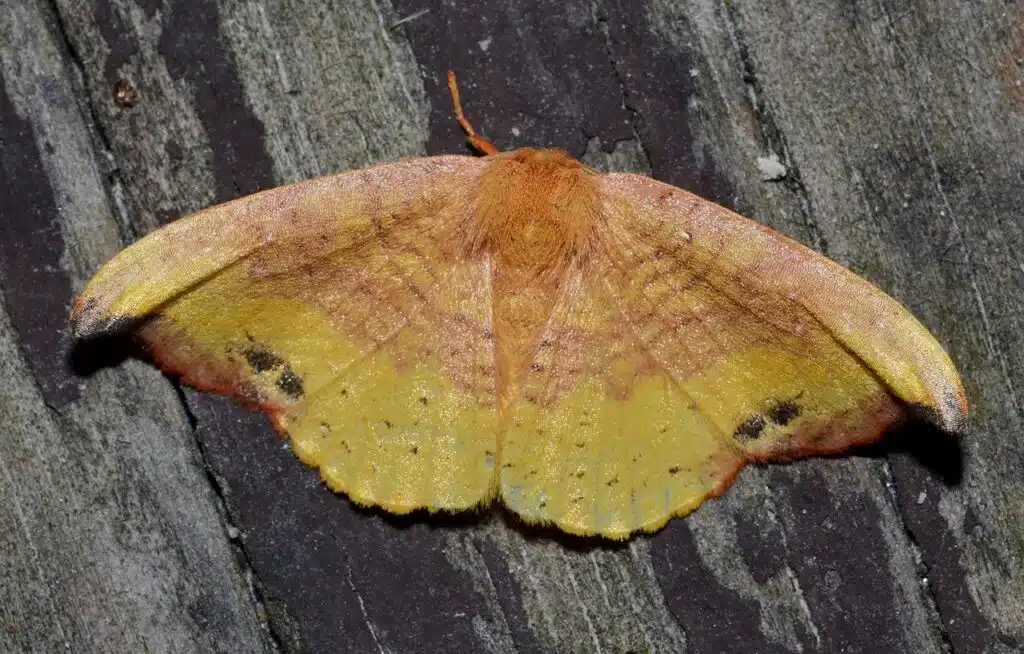
Rose Hooktip moths (Oreta rosea) are a North American species that mimic tree leaves as a means of defense.
These moths are common across woodlands where they aren’t seen easily based on a dark yellow dorsal color and a dark brown ventral color.
This species has brown forewings and light yellow hindwings.
Brown is also the main color of the wings around the head.
Darker brown coloring is specific to the ventral wings of the species. Black and brown veins are distinguishable on this side of the wings with some resembling the veins on tree leaves.
Rose Hooktip caterpillars are seen feeding on birch leaves.
19. Yellow Slant-Line
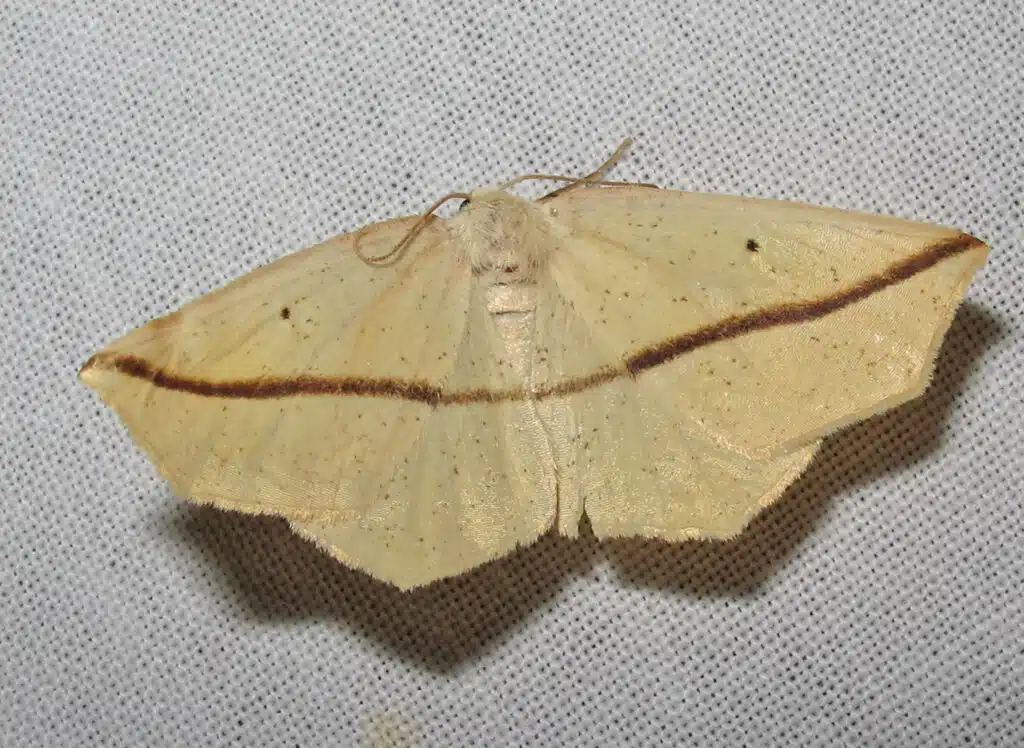
Yellow Slant-Line moths (Tetracis crocallata) get their name from their color. This moth species has a pale yellow color characteristic to both the forewings and the hindwings.
This pale yellow color is also seen across its body. The wings are further decorated with a curved line that runs from the outer edges of the forewings inwards.
This line makes the species look like a leaf.
A camouflaging appearance is specific to the Yellow Slant-Line. Even the caterpillars of the species have a camouflaging twig-like shape.
You can find Yellow Slant-Line moths across multiple Eastern US states.
20. Yellow-winged Pareuchaetes Moth
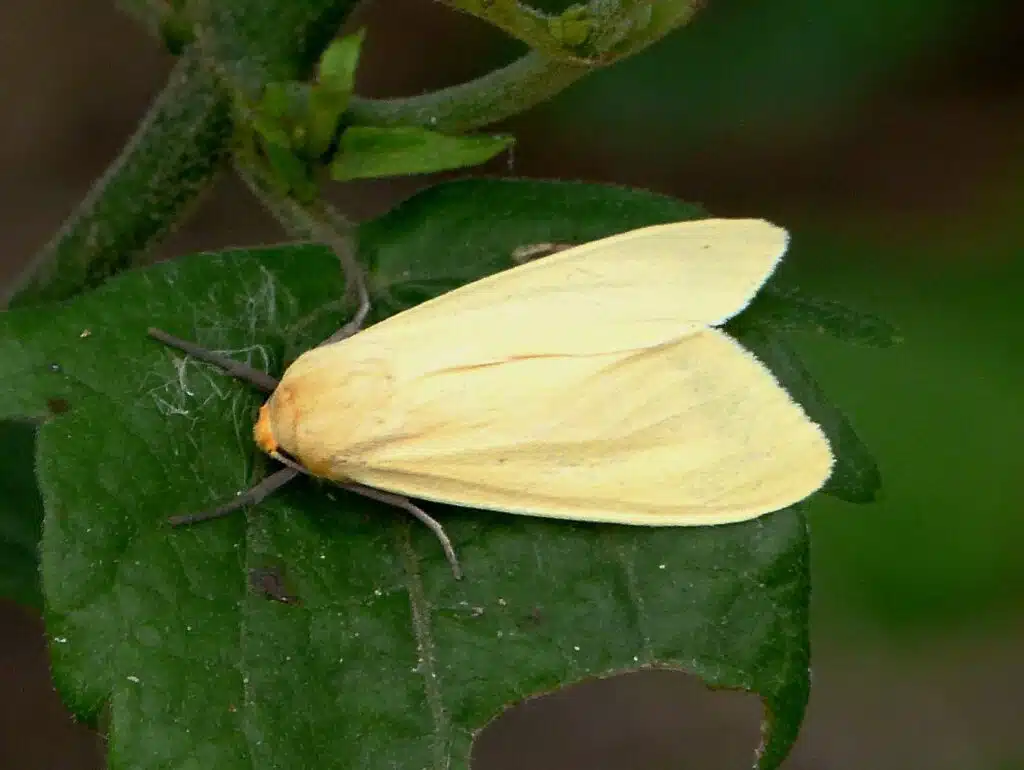
This species of yellow moths (Pareuchaetes insulata) are seen in the Southern parts of the US as well as in Central American countries such as Guatemala.
Yellow-winged Pareuchaetes Moths have a pale yellow color that appears uniform across the wings and the body.
This species has a wingspan of up to 38mm but it is commonly seen in a smaller size in the US.
Southern climates favor early flight season starting in April.
Habitats rich in asters are the areas where you can see the Yellow-winged Pareuchaetes Moths.
Arizona and Florida are states with high Yellow-winged Pareuchaetes Moth populations.
21. Soft-lined Wave
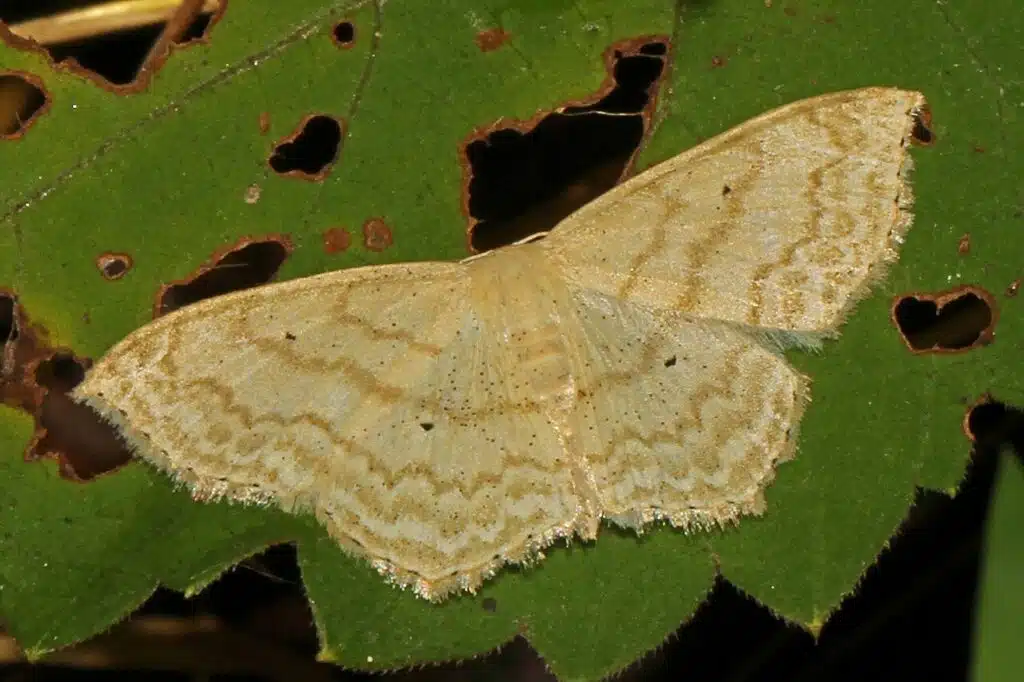
The Soft-lined Wave moth (Scopula inductata) is dominated by yellow coloring.
Its name comes from the gray lines or patterns on the wings which look similar to waves.
This species has a wingspan of up to 25mm. It can be found in all Central and Eastern states of the US.
Soft-lined Wave moths feed on herbs and small flowers.
Asters and dandelions are among the favorite foods together with ragweed.
This species is mostly seen during the summer when these flowers are in season. They only remain active until the start of September.
22. Nais Tiger Moth
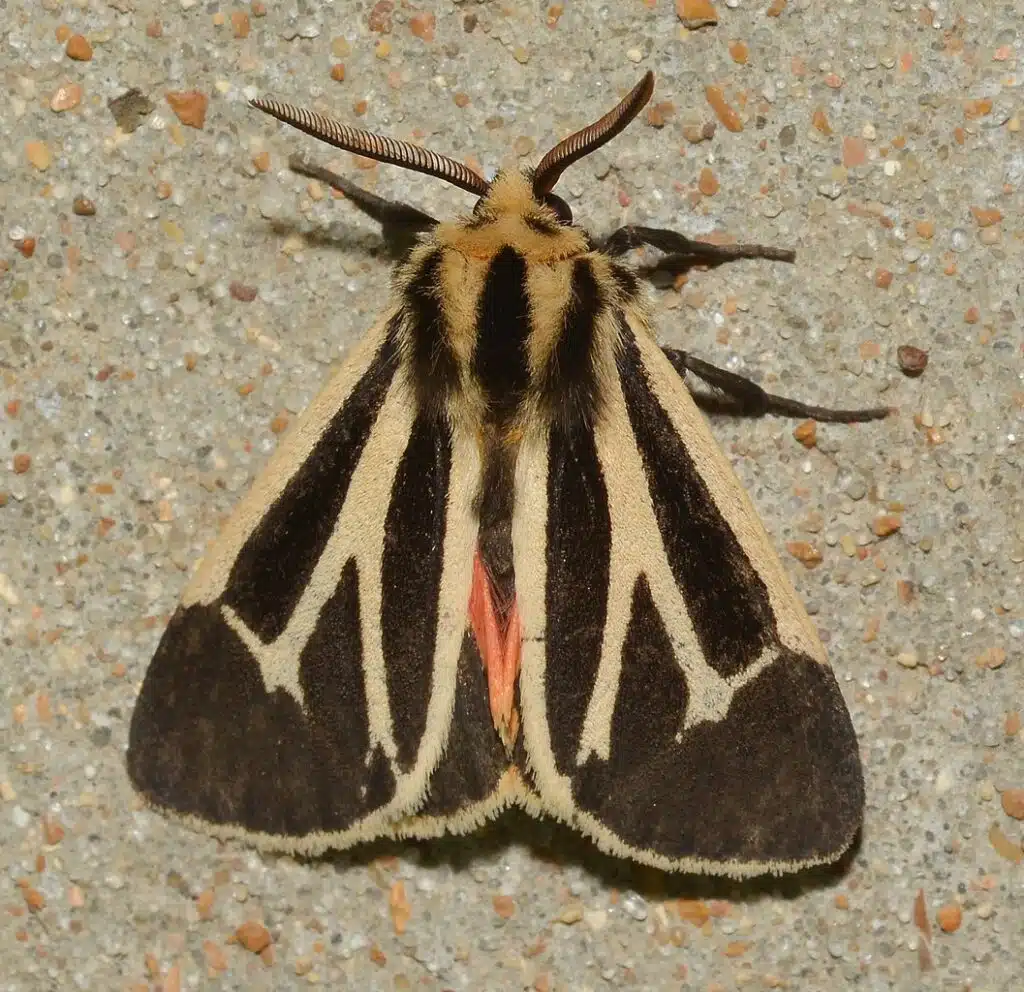
The Nais Tiger Moth (Apantesis nais) is only found in Northern US states such as Ohio.
This species has a limited territory but it stands out with its colorful wings.
A different pattern is specific from the forewings to the hindwings. The forewings are brown with yellow stripes.
The hindwings are yellow or off-white with marginal brown coloring.
Brown is also the dominant color across the body of the species.
This species grows to a wingspan of up to 42mm.
Nais Tiger Moths are seen in different habitats such as open areas and the edges of woodlands.
Short flowers and herbs are the main food source for the species. Violets and clovers are a good nectar source for these moths.
Nais Tiger Moths also feed on various types of grass found in parks and gardens.
23. Stained Lophosis
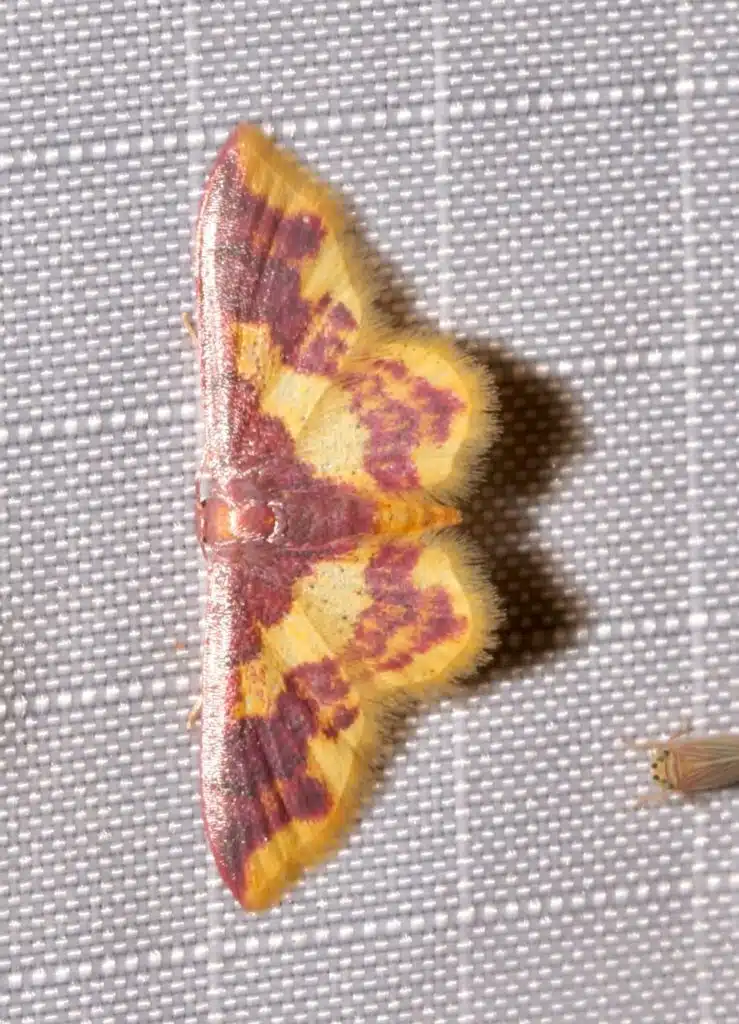
Stained Lophosis moths (Lophosis labeculata) have dual-color wings. This species has purple to brown coloring with yellow sections across the hindwings in the case of males.
Females of the species have both purple-brown and yellow coloring on the forewings and the hindwings.
A rare morph of this species has violet and yellow alternate coloring.
The body of the species is also characterized by these 2 colors.
The species is the most common on the Eastern Coast.
High populations of Stained Lophosis are seen in the Northern parts of New Jersey down to the Southern coasts of Florida.
Adult Stained Lophosis moths are active until December in Florida.
24. Maple-Basswood Leafroller Moth
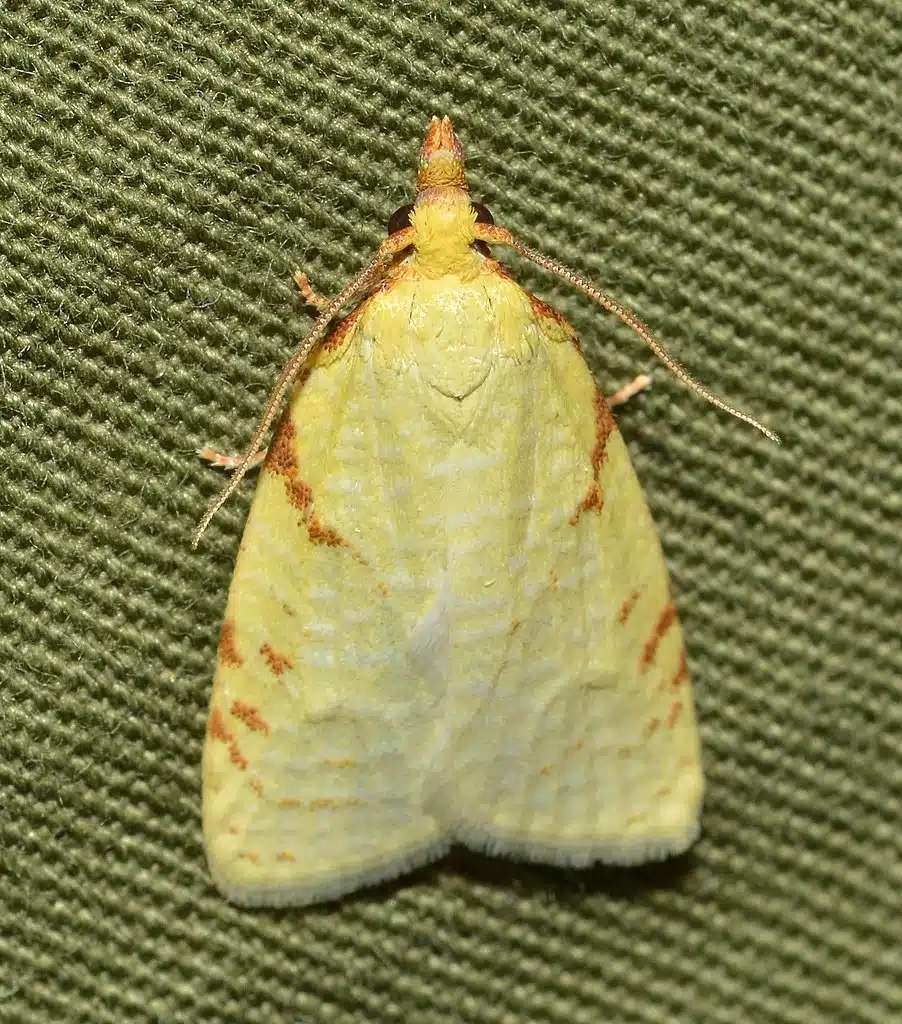
Maple-Basswood Leafroller Moths (Cenopis pettitana) have yellow and pale yellow coloring across their wings.
Its forewings are mostly dark yellow with light brown margins.
The hindwings of the species have light yellow coloring. These hindwings almost appear transparent as well.
The body of the specie is split between the different yellow nuances.
Darker yellow is specific to its upper body while pale yellow is specific to its lower body.
Maple and basswood are among the preferred host species for the adult moth to lay eggs on. Fruit-bearing trees are also a common host for the moth that rolls leaves to protect the eggs.
25. Dotted Diatraea
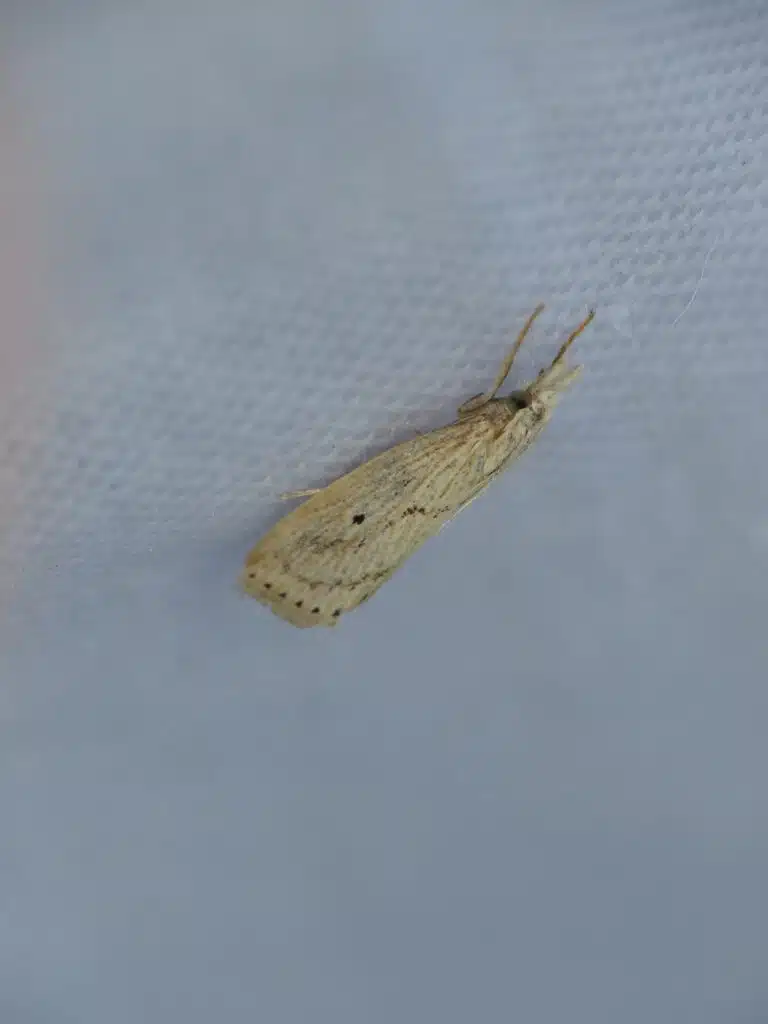
Dotted Diatraea (Diatraea lisetta) is a species of pale yellow to white moths.
The name of these moths is inspired by the bright yellow color of the wings. Tiny black dots are further visible across the wings of the species.
You can identify this moth by its multiple black spots and large black eyes.
Known as a small species, the moth only grows to an average wingspan of 20mm.
Alabama and Florida are the states where the Dotted Diatraea species is most common. This species also lives in Central America in states such as Panama.
26. Oak Leafroller Moth
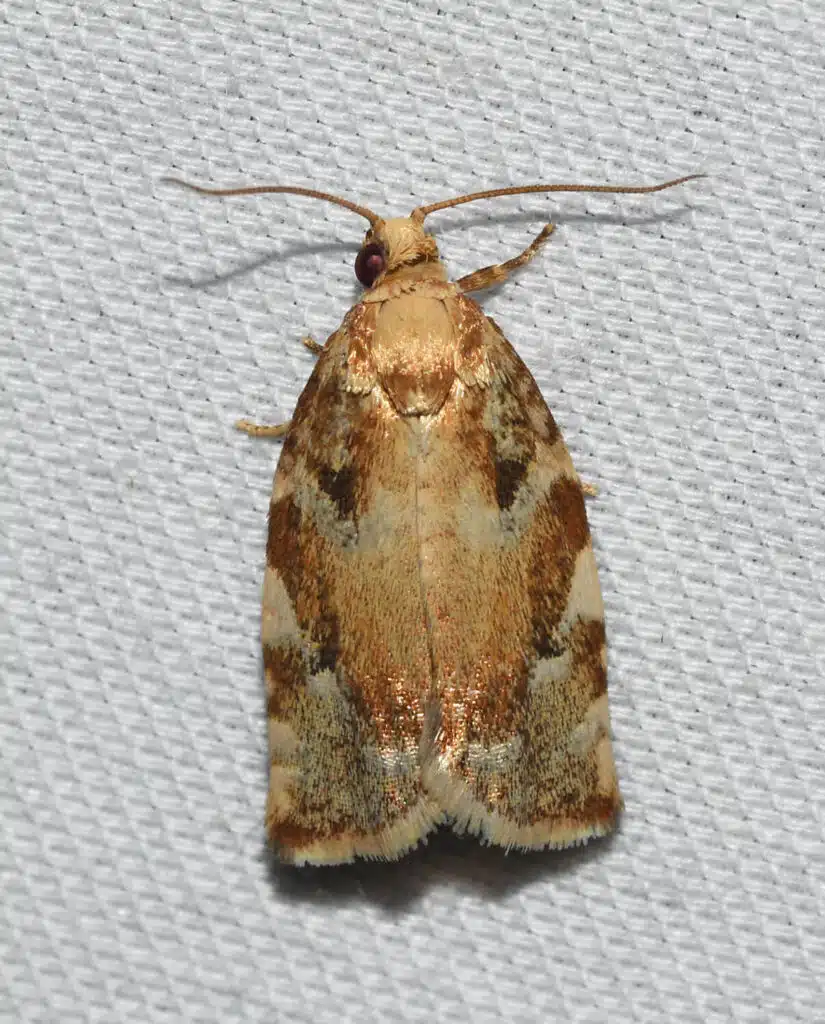
Oak Leafroller Moths (Archips semiferanus) often come in yellow and white colors as well as in brown alternate colors.
As the name implies, the moths of this family are mostly known for living on oak trees.
However, these moths are serious pests of oak trees across Northern states and Northeastern US states where there are many oak woodlands.
Both the larvae and the adults of the species are known for impacting oak trees. Adults can defoliate the trees completely.
Killed oak trees are a common sight in areas where these moths settle.
A large cluster of eggs is specific to the species and partially responsible for killing oak trees.
Females can lay up to 50 eggs each which means oak tree damage is often fatal to the host oak.
27. Kyoto Moth
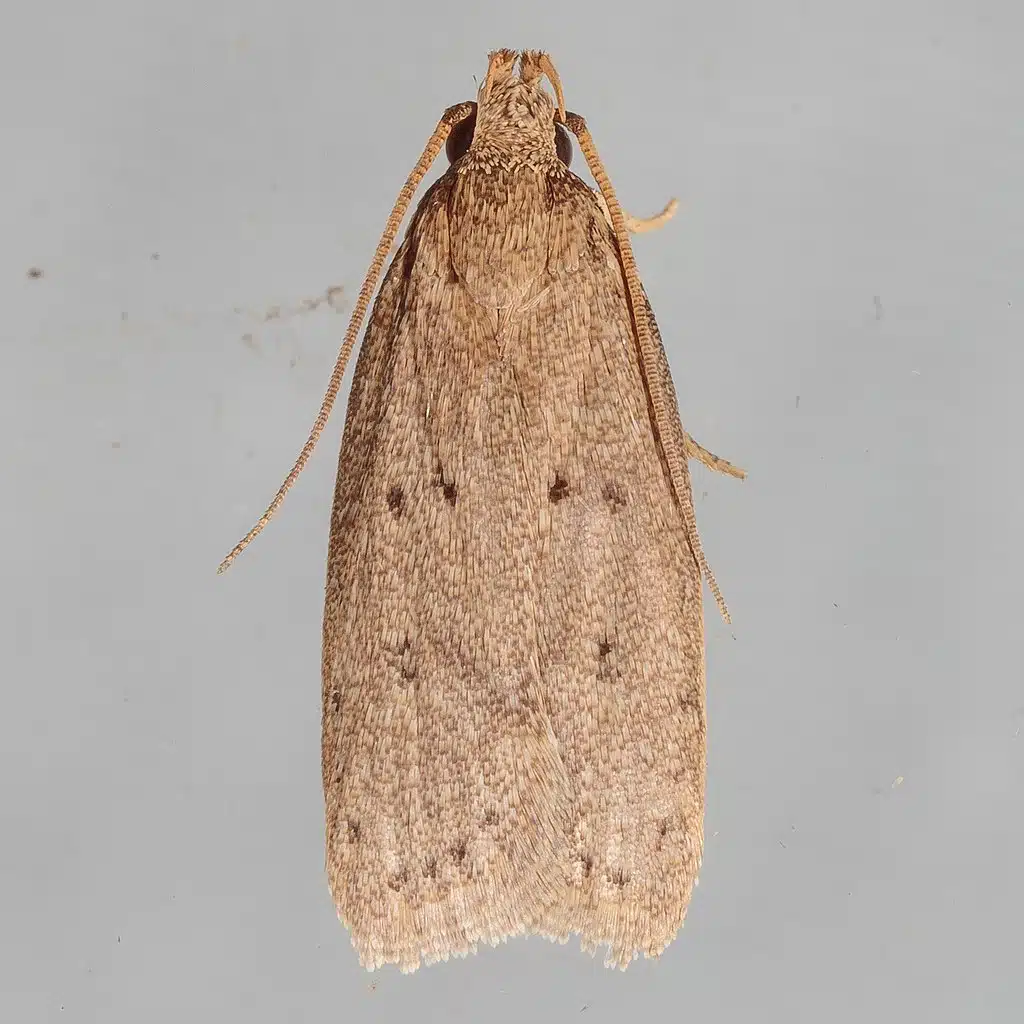
The Kyoto Moth (Autosticha kyotensis) is a species introduced to North America. This moth has a bright yellow color with dark brown spots.
Native to Japan, the Kyoto Moth is present across the Eastern states of the US.
Its host plants are atypical for other yellow moths through their introduced status.
The larvae of the Kyoto Moth are known to feed on cedar, Chinese, and Japanese plum.
A reduced selection of host species means the Kyoto moth caterpillar has a negative role in the lifespan of these trees in the case of a serious outbreak.
28. Lemon Plagodis Moth
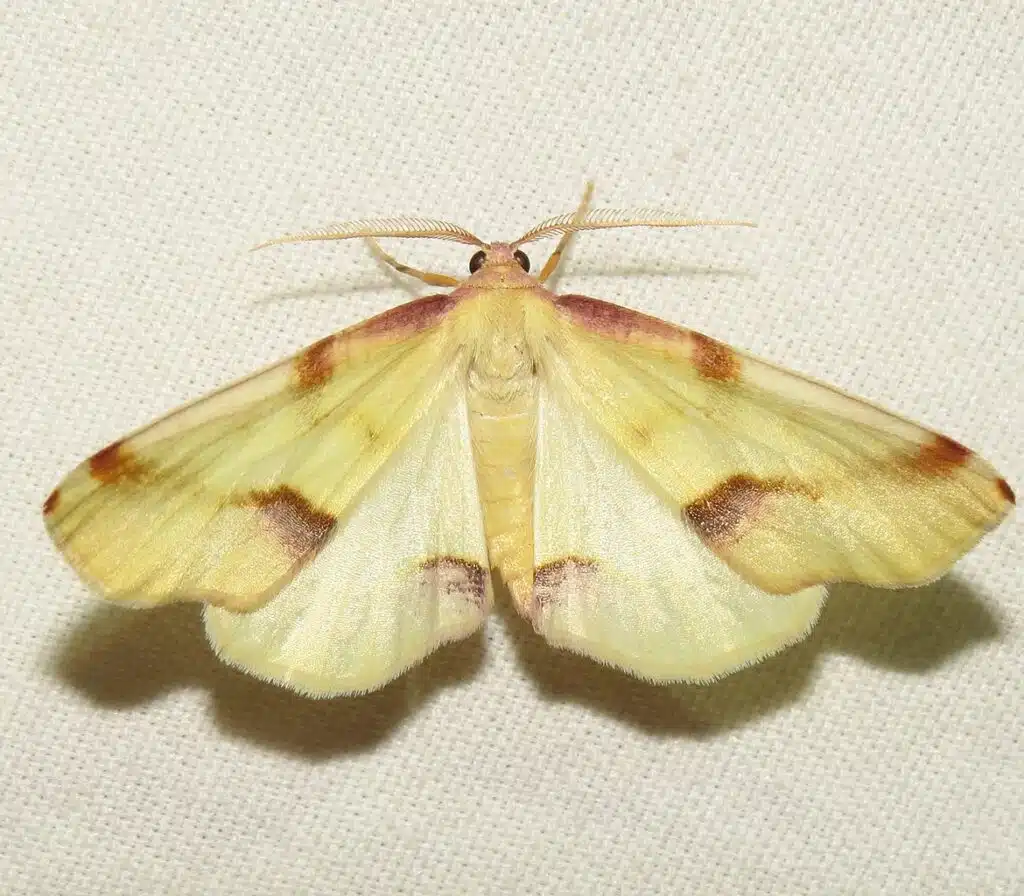
The Lemon Plagodis Moth (Plagodis serinaria) is a common yellow species in North American woodlands.
Moths of this species have a yellow-dominant coloring. Their wings also show pink, red, or violet coloration.
Lemon Plagodis Moths have a medium size for yellow moths in North America. They have a wingspan that measures a maximum of 27 to 38m.
You can find these moths across the US, especially in deciduous woodlands.
The species is seen on various host trees.
Aspen and basswood are common host trees for the species and other yellow moths. Black cherry trees are another common host.
Lemon Plagodis Moths have a potentially deadly impact on host trees since these common trees are also hosts for other moths.
29. Yellow-dusted Cream Moth
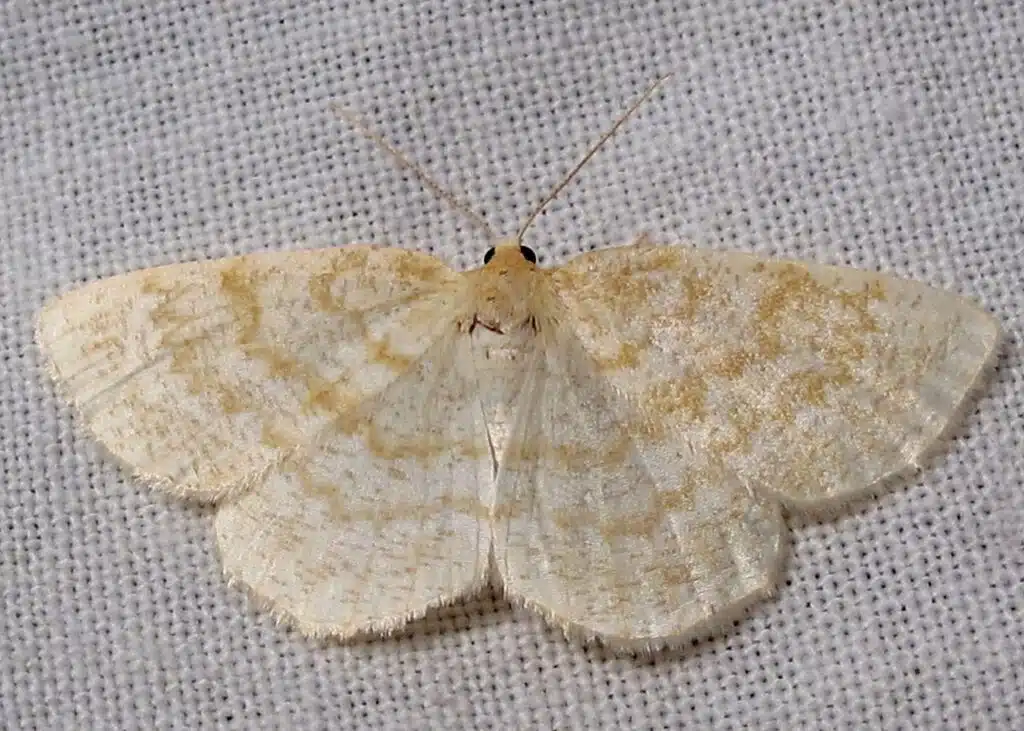
Yellow-dusted Cream Moths (Cabera erythemaria) have pale yellow coloring.
This species can also be found in a white morph.
The wings of the species have an almost uniform color as there aren’t too many visible patterns across.
Darker yellow lines are sometimes visible on the wings of the moth.
Like other yellow moths, the Yellow-duster Cream Moth is present across woodlands, mainly in birch woodlands.
Willows are another common host for this moth species as well as for other North American moths.
You can see Yellow-dusted Cream Moths on birch across the US from May to August.
Unlike other yellow moths, the Yellow-dusted Cream Moth has a presence both on the East Coast and on the West Coast.
30. Half-yellow Moth
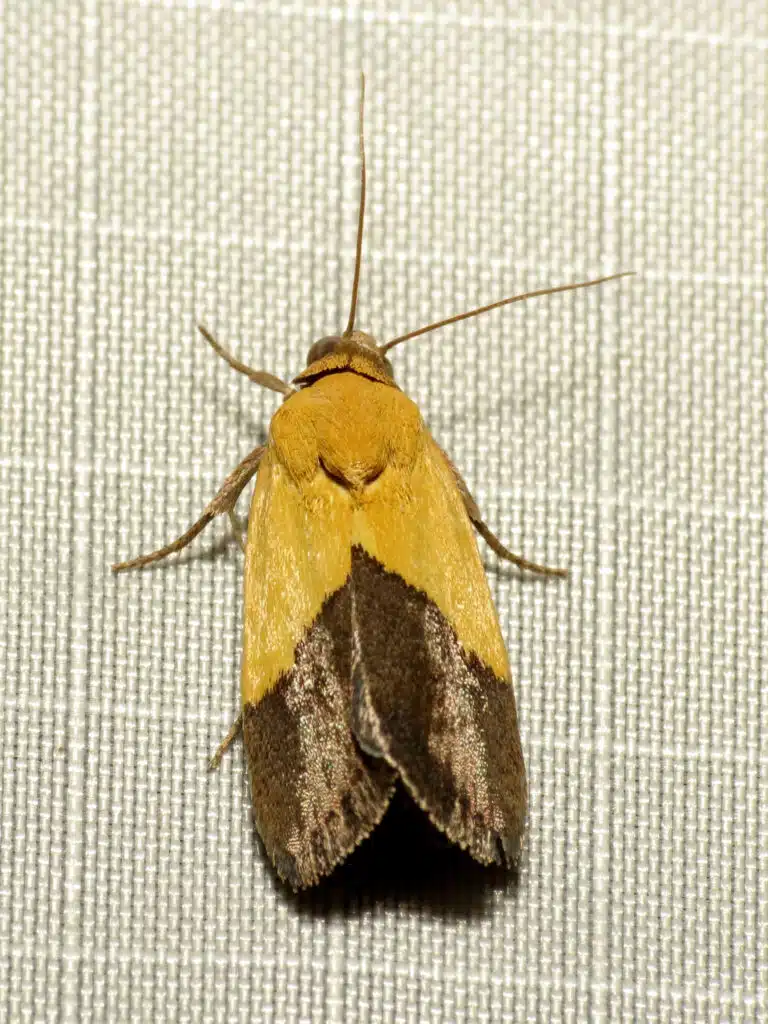
The Half-yellow Moth (Ponometia semiflava) gets its name from its dual colors.
Moths of the species have both brown and yellow coloring which makes for a contrasting look.
Matte yellow and matte brown are the colors of the upper wings.
Moths of the species are native to the US but they prefer to live in sandy areas. Dunes and old beaches are places where the moth is seen in higher numbers.
These moths live both in the Northern and Southern states.
They feed on various types of asters. Maryland golden asters are the yellow flowers they feed on in the North.
The species has a different flight season depending on its region.
It has an extended season in Southern states where it can be seen from early March to August.
31. Obtuse Yellow
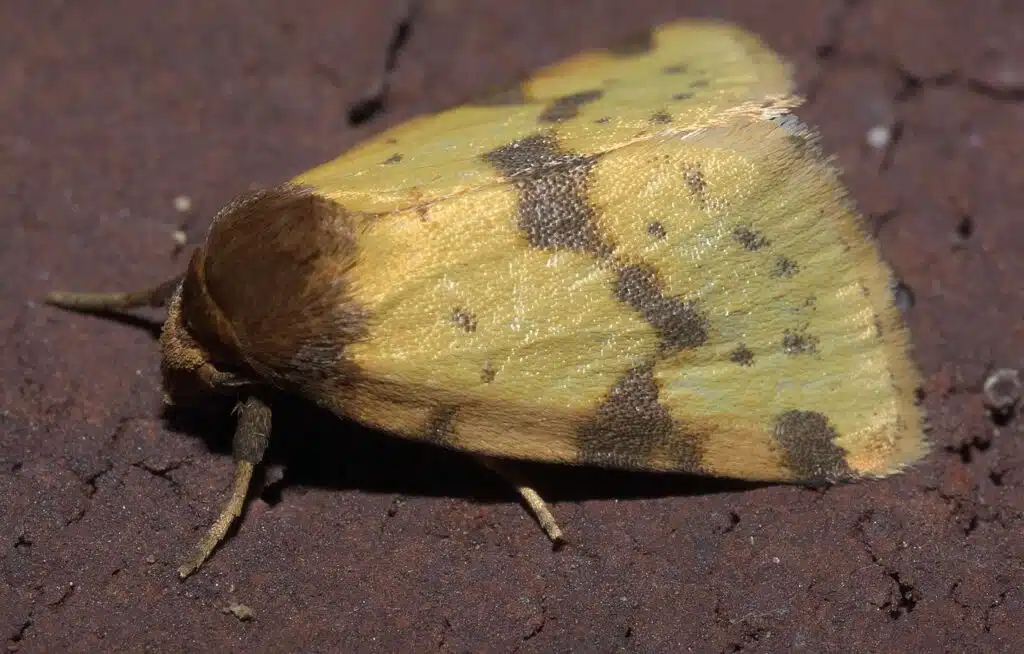
Obtuse Yellow moths (Azenia obtusa) have a base yellow color on the forewings and the hindwings.
Brown spots are seen on the forewings while the hindwings have black patterns on a base yellow color.
While both the forewings and the hindwings are yellow, some nuance differences are seen within the species. The forewings of the species have darker yellow coloring.
Found both in the US and in Canada, the Obtuse Yellow moth is known to feed on asters.
It doesn’t feed on all asters as it prefers the flowering giant ragweed genus.
This flower has similar flowering yellow colors to the wings of the moth.
32. Southern Flannel Moth
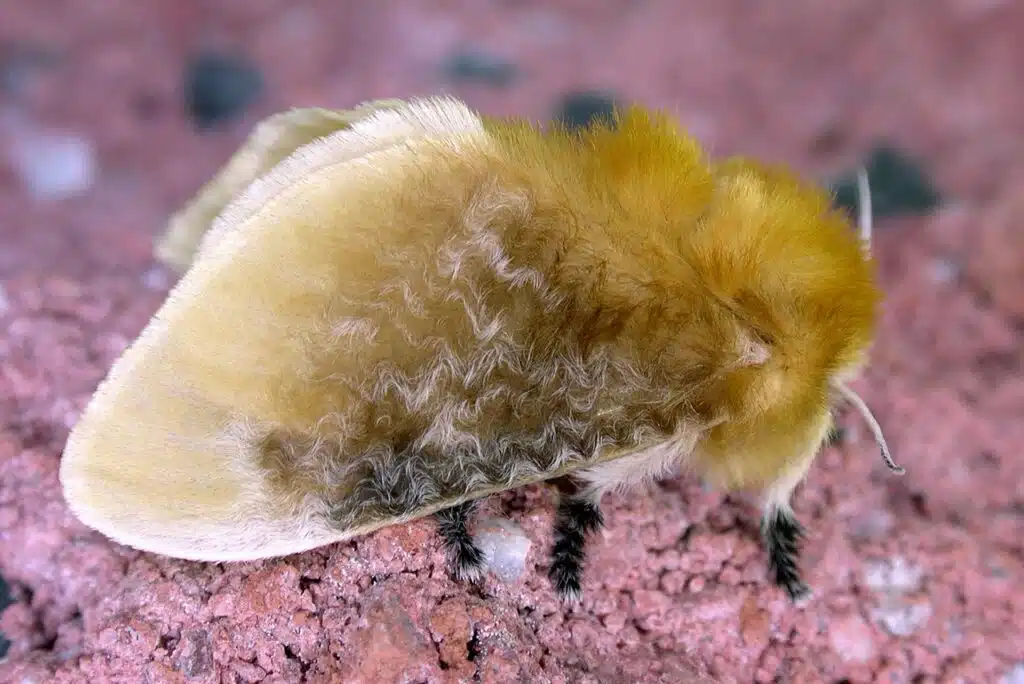
Southern Flannel Moths (Megalopyge opercularis) are some of the most distinct species found in Southern US territories among yellow moths.
A fur-like coat of the yellow species makes it stand out,
Brown and white marks are seen across the forewings of the species.
Yellow coloring is more specific to the body and the hindwings.
Southern Flannel Moths are relatively small. They have a maximum wingspan of 1.5 inches.
One of the main reasons to avoid this species is its venomous caterpillars.
The Southern Flannel Moth caterpillar is identified by a hairy body with long hollow bristle-like hairs.
Venom glands are found at the base of these bristle hairs. Touching these caterpillars leads to irritation.
The exact extent of the health risks associated with the venom of the caterpillar is still unknown.
33. Black-bordered Lemon Moth
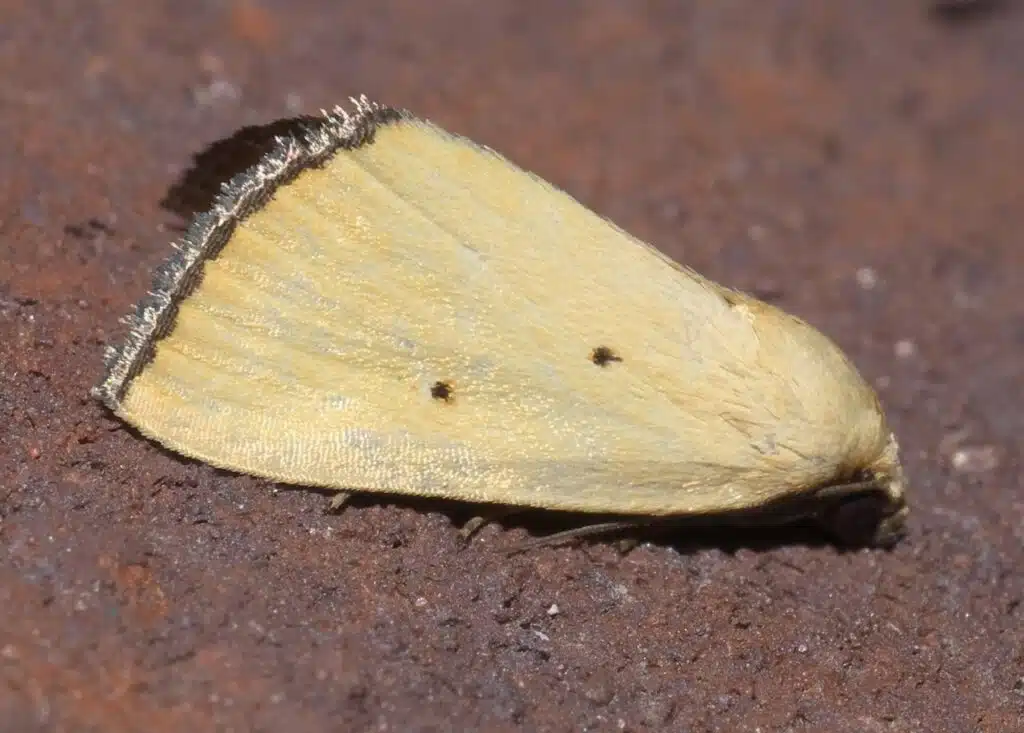
Native to Eastern US states, the Black-bordered Lemon Moth (Marimatha nigrofimbria) is a small species with a yellow wing.
Light yellow coloring is specific to this species. As its name suggests, wide brown borders are also seen on its forewings.
Small brown spots are also visible on the wings of the species.
Gray and brown morphs of the Black-bordered Lemon Moth are also found in the Eastern US states.
You can find the species on various types of vegetation such as crabgrass where its caterpillars grow.
Morning glory flowers are also a common host species for the Black-bordered Lemon Moth.
34. Lentiginos Moth
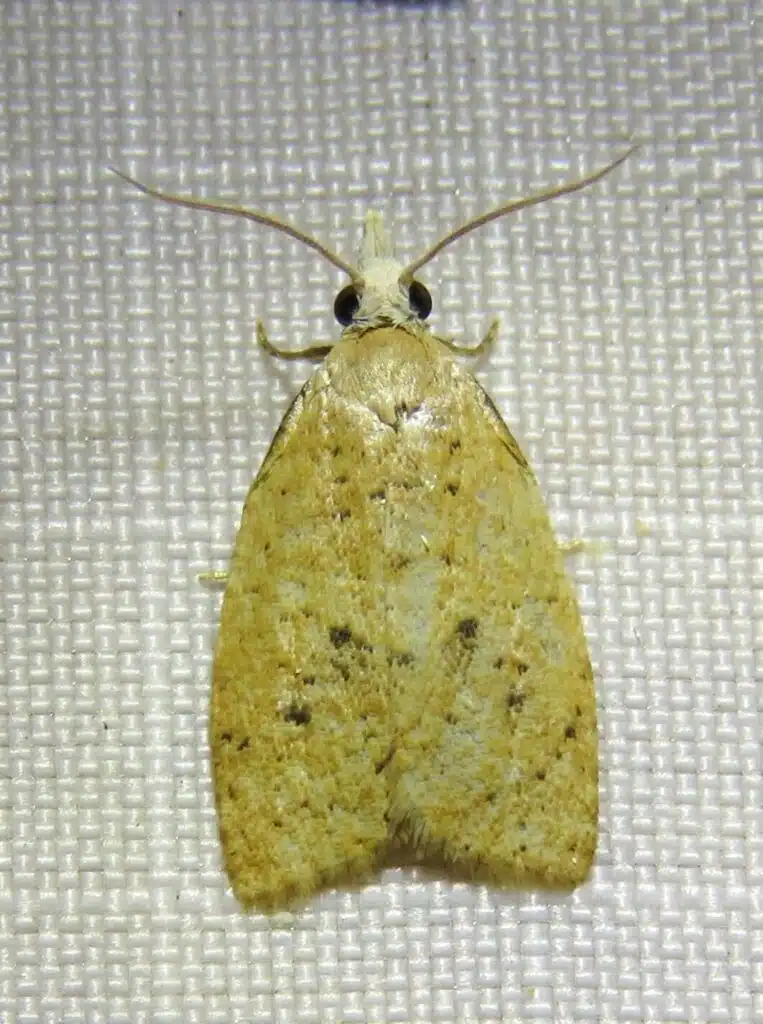
Lentiginos Moths (Sparganothoides lentiginosana) are a native US species with a Florida Southern border and a widespread presence in Central America.
The species has a yellow-brown color with brown dots across the wings.
You can find these moths in almost any type of habitat on the Eastern Coast.
Lentiginos Moths are found at high elevations on pine trees.
The caterpillar of the species is known for being a pest of various apples.
You can also find Lentiginos Moth caterpillars on the common yarrow plant.
This species has a long flight season in Southern habitats where it can be seen almost throughout the year.
35. Harnessed Tiger Moth
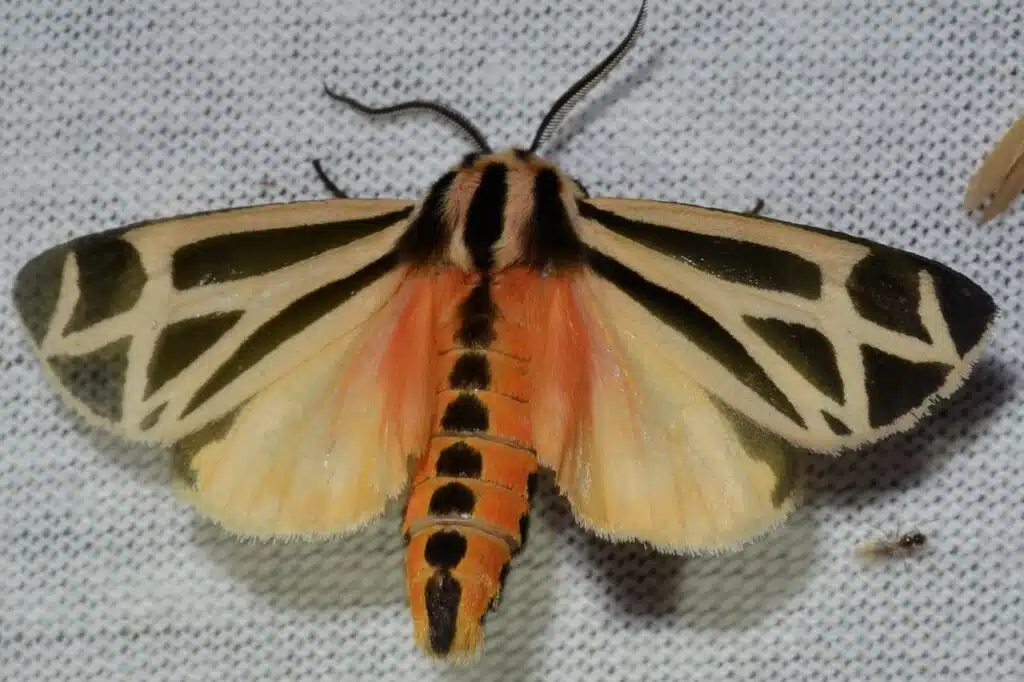
The Harnessed Tiger Moth (Apantesis phalerata) is a species that resembles the coloring of most US native tiger moths.
Black and yellow colors are characteristic of this species. Black wings with yellow bands are seen on members of this species.
The red coloring is identified next to the head region of the wings.
You can find the caterpillars of the species on the common clover plant moths as well as on other species such as dandelions.
Moths of this genus are typically only active until August.
They have multiple natural predators despite coloring which makes them difficult to spot. Bats are among the most common Harnessed Tiger Moth predators.
36. Banded Tussock Moth
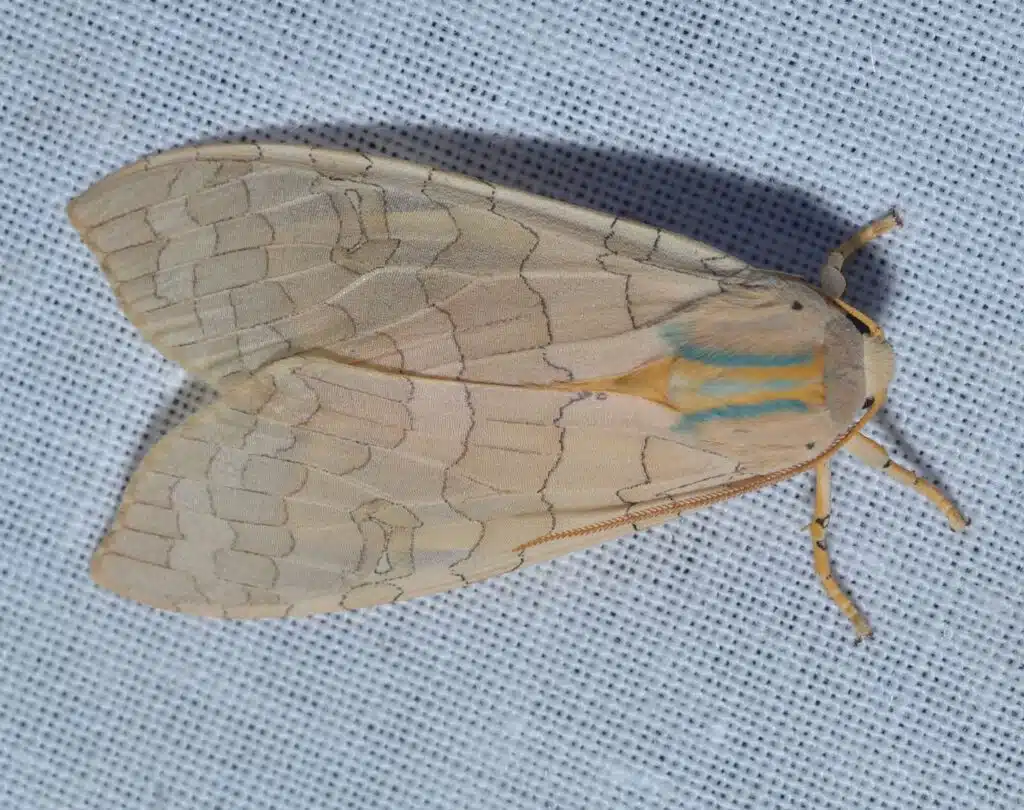
Banded Tussock Moths (Halysidota tessellaris) have a yellow base color of the wings with dark yellow or gray bands across.
Moths of this species are known for eating dead plants and dead leaves. It seems this species eats decaying organic matter for an intake of chemicals that give them a bad taste to potential predators.
The species further stands out as one of the invasive moths of hardwood trees.
Alder and birch are among the species most commonly seen as a host tree by the Banded Tussock Moth. This species is also seen on hazel and walnut trees.
37. Paler Diacme Moth
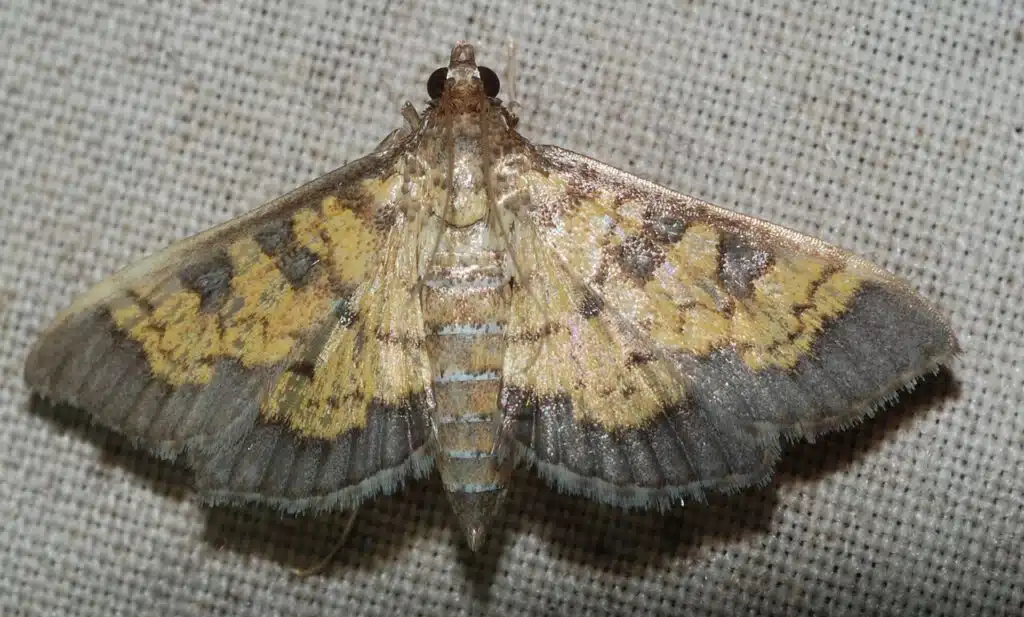
With a wingspan of 17 to 23mm, the Paler Diacme Moth (Diacme elealis) is a small moth species native to North America.
This species has mostly yellow wings. These wings are decorated with brown patches, brown veins, and wide brown margins.
A common sight across Florida, the PALE Diacme Moth is also seen across Central America.
With a few broods per year, the species is active through September.
38. Sparganothis Fruitworm Moth
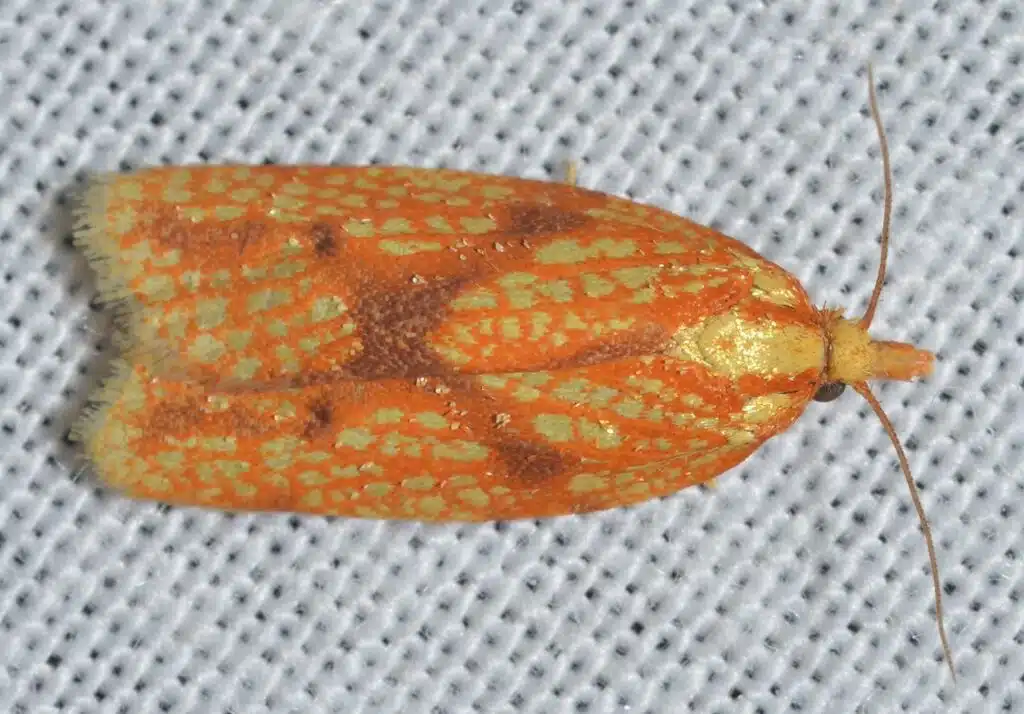
These moths (Sparganothis sulfureana) have yellow and orange coloring. A base yellow color is distinguished on its wings together with orange to brown patterns.
Light orange spots are further distinguishable on its forewings.
Native to North America and Cuba, this moth has 2 broods per year in its warm natural habitat.
The species is a minor pest of corn. It’s also seen eating cranberry fruits and cranberry leaves.
Sparaganothis Fruitworm Moths are some of the smallest yellow moths in North America.
This species has a maximum wingspan of 10 to 20mm.
Moths of this family are active until October.
39. Lemon Yellow
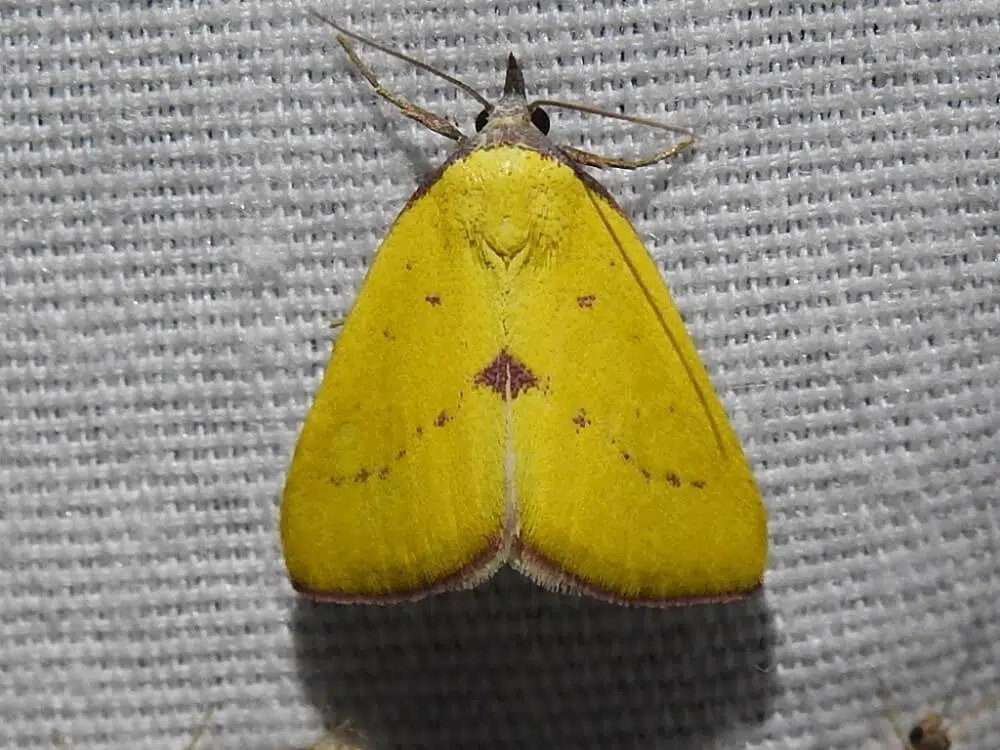
Common in the North and the Northeastern US states, Lemon Yellow moths (Phytometra orgiae) have yellow and white coloring.
The species has dual coloring as one color is seen on the forewings and another color is seen on its hindwings.
Yellow is specific to the forewings while the hindwings are white.
This moth also has orange margins on the forewings and gray margins on the hindwings.
You can find Lemon Yellow in high numbers across Ohio.
This species is only seen in a group of milkwort plants.
Its caterpillar sees milkwort as the ideal host plant.
Unlike the caterpillars of other yellow moths, the Lemon Yellow caterpillar feeds on the stems and roots of its host plant and not on its leaves.
40. Beautiful Sparganothis
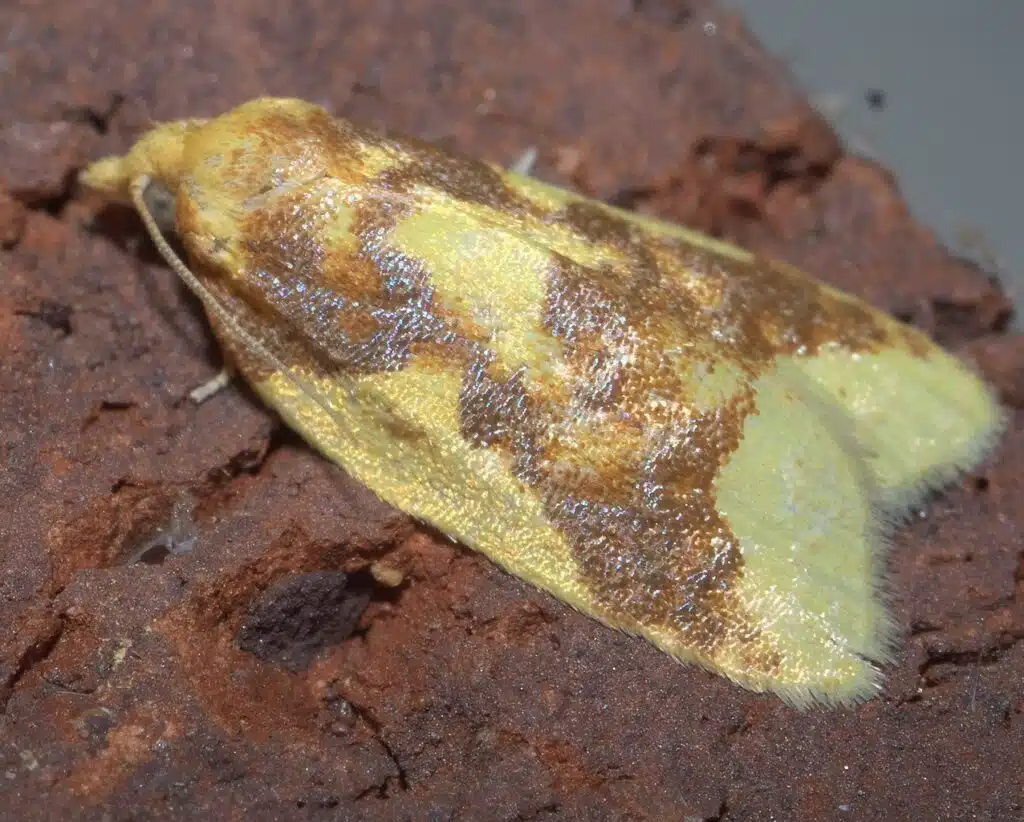
This species of moths (Sparganothis pulcherrimana) are native to Eastern North America.
It’s one of the small moth species on the continent with a maximum wingspan of 17mm.
Beautiful Sparaganothis is one of the few moths confused with the similarly-colored and similarly-sized Aproned Cenopis Moth.
Both species have a base yellow color with either orange or brown bands. These bands are wide and cover a large section of the wings.
There are no margins of the wings and no colored patterns across the forewings or the hindwings.
Beautiful Sparaganothis moths are also among the few species that appear as early as April. The season of the species typically ends in June.
41. Oak Leafshredder Moth
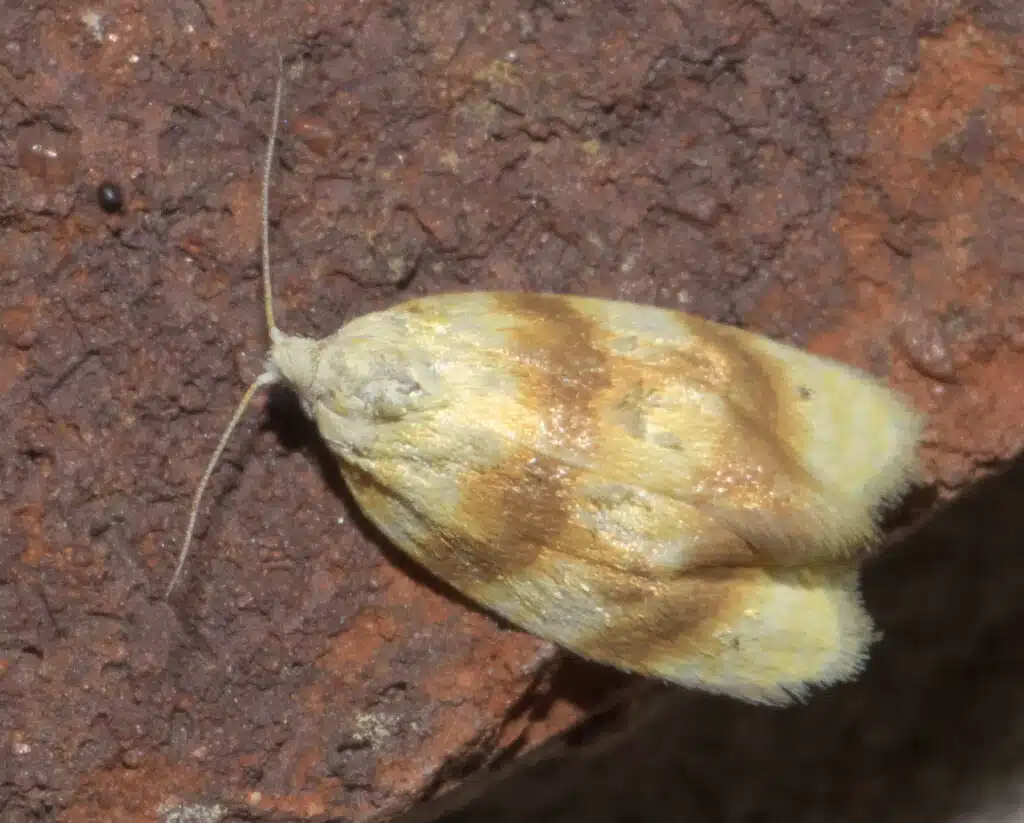
Oak Leafshredder Moths (Acleris semipurpurana) come in different colors. These moths can have a white color or even a yellow color. Rare morphs of the species are black.
As the name implies, these types of moths are a common sight on oak trees.
Oak Leafshredder Moths invade various species of Northeast US oak such as red oaks.
Their impact isn’t immediate but these moths can still kill a young oak tree.
It can take 2-3 years for these moths to cause sufficient damage that causes stunted tree growth.
These moths eat oak tree leaves. They leave small holes in the leaves behind them.
Oak Leafshredder Moths are also seen on other species of Northern oaks such as pink oak and scrub oak.
42. Golden Wave
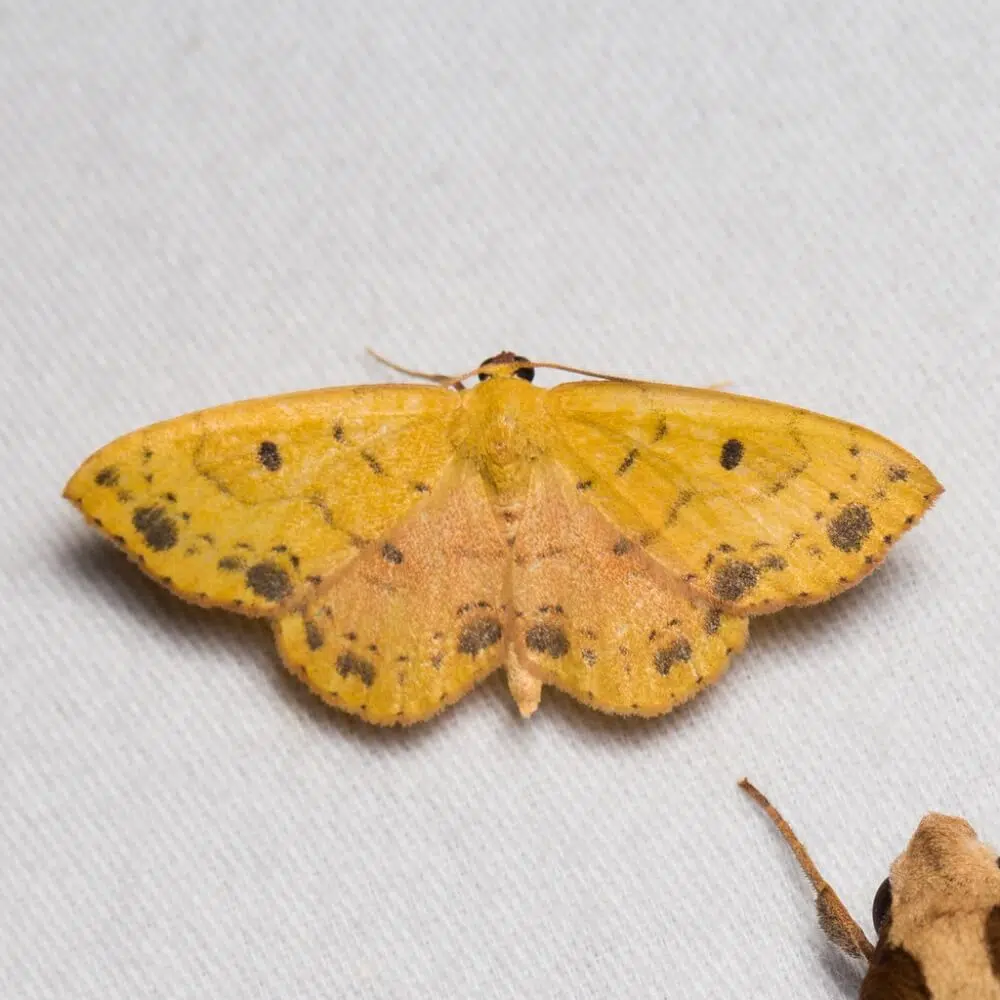
Golden Wave moths (Semaeopus ella) have a yellow color across the forewings and the hindwings. This species has 4 black eyespots on the wings and gray to black lines in the shape of waves.
Other morphs of the species have dark yellow coloring with brown margins.
The ventral coloring of the species is mostly brown.
With a combination of light and dark brown, the Golden Wave moth has the ventral appearance of a dead leaf.
43. Alamo Moth
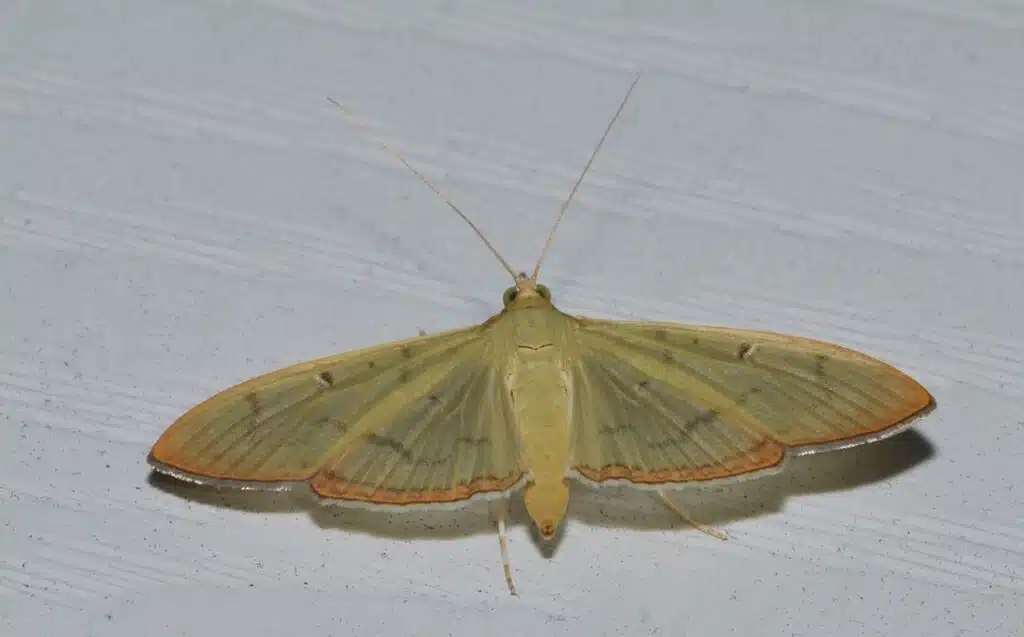
Alamo Moths (Condylorrhiza vestigialis) are present in all Southern states from Texas to Florida.
This species has yellow dorsal coloring but it also comes in a brown color.
Its yellow color has a bright color across the forewings and the hindwings.
Its body is also mostly bright yellow with a yellow head and yellow antennae.
Red to brown marks or stripes are seen across the wings.
The brown morph of the species also shows faint yellow margins on the hindwings and a yellow lower body.
44. Yellow Mocis Moth
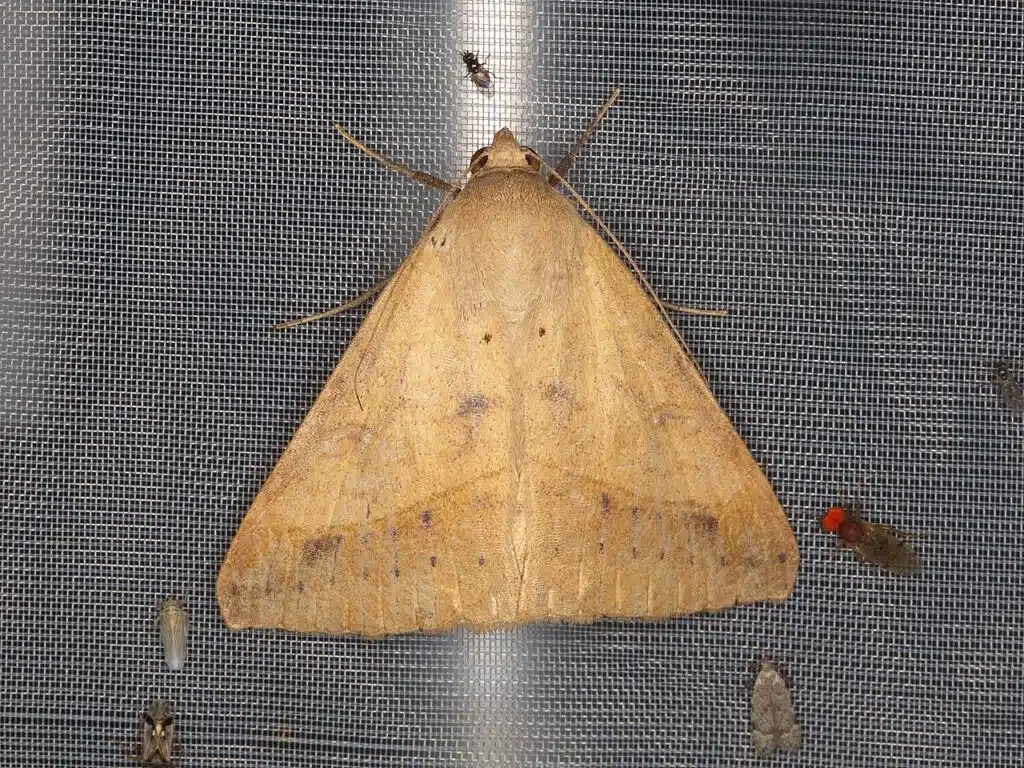
Yellow Mocis Moths (Mocis disseverans) have a small to medium size. It has a wingspan of up to 40mm.
This species is also found across Southern US states, similarly to Alamo Moths.
Texas, Louisiana, Alabama, and Florida are the states in which this moth is prevalent.
Moths of this genus come in a dark yellow color and they’re also available in a brown color.
The Yellow Mocis Moth has a dark yellow color with black spots and visible dark veins.
Faint gray bands are further distinguished on the hindwings of the species. The color of this moth tends to darken with age.
Further Reading: